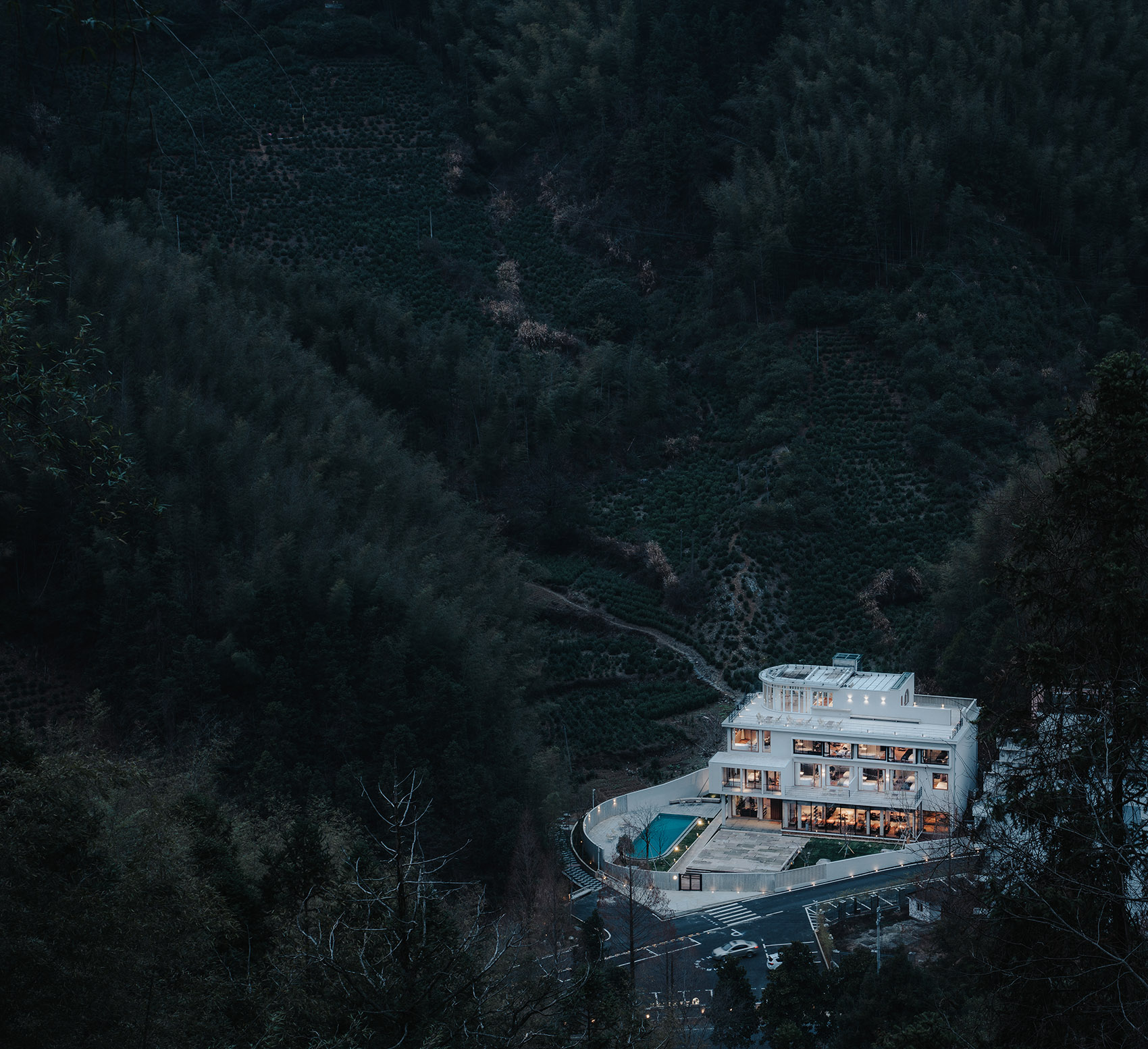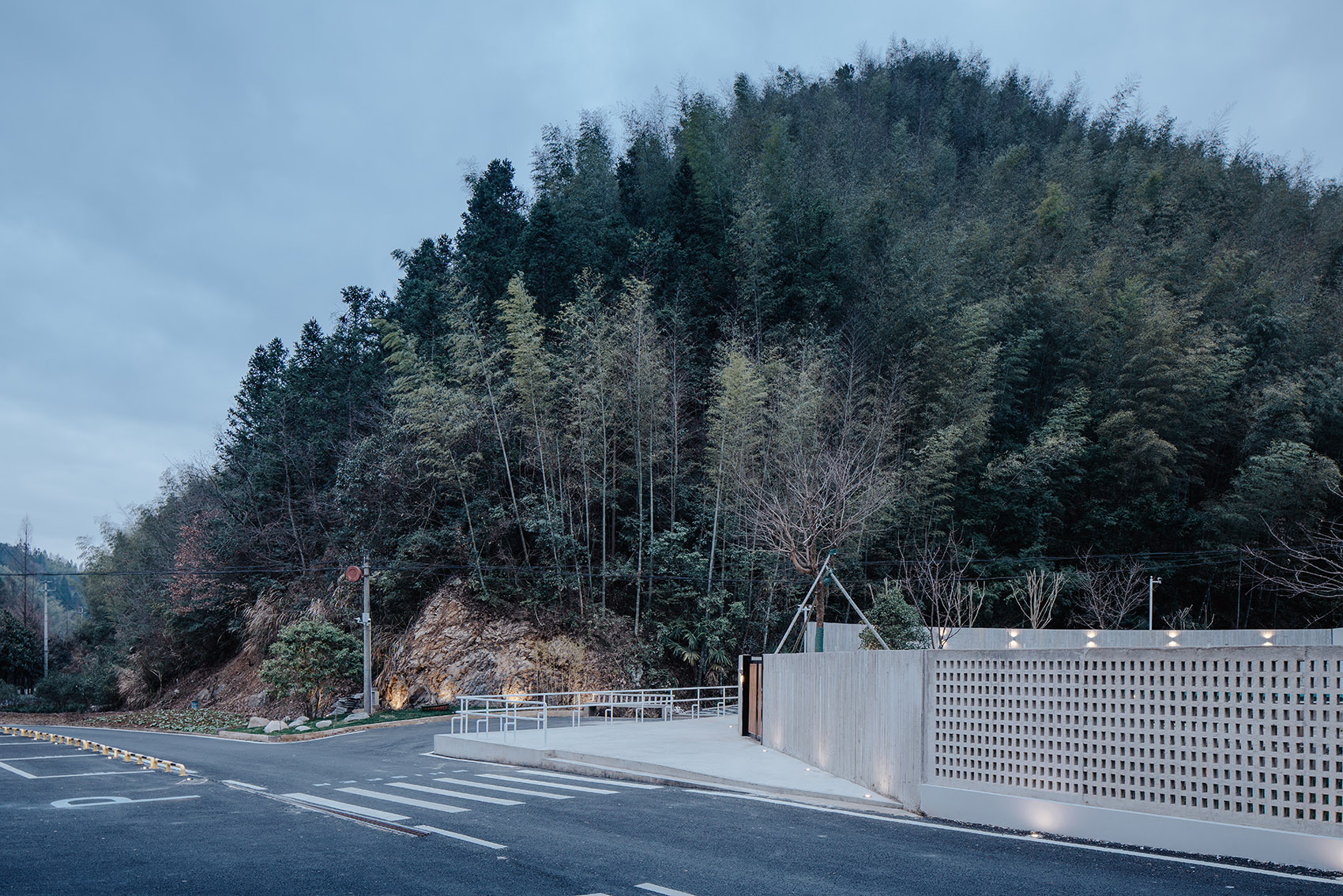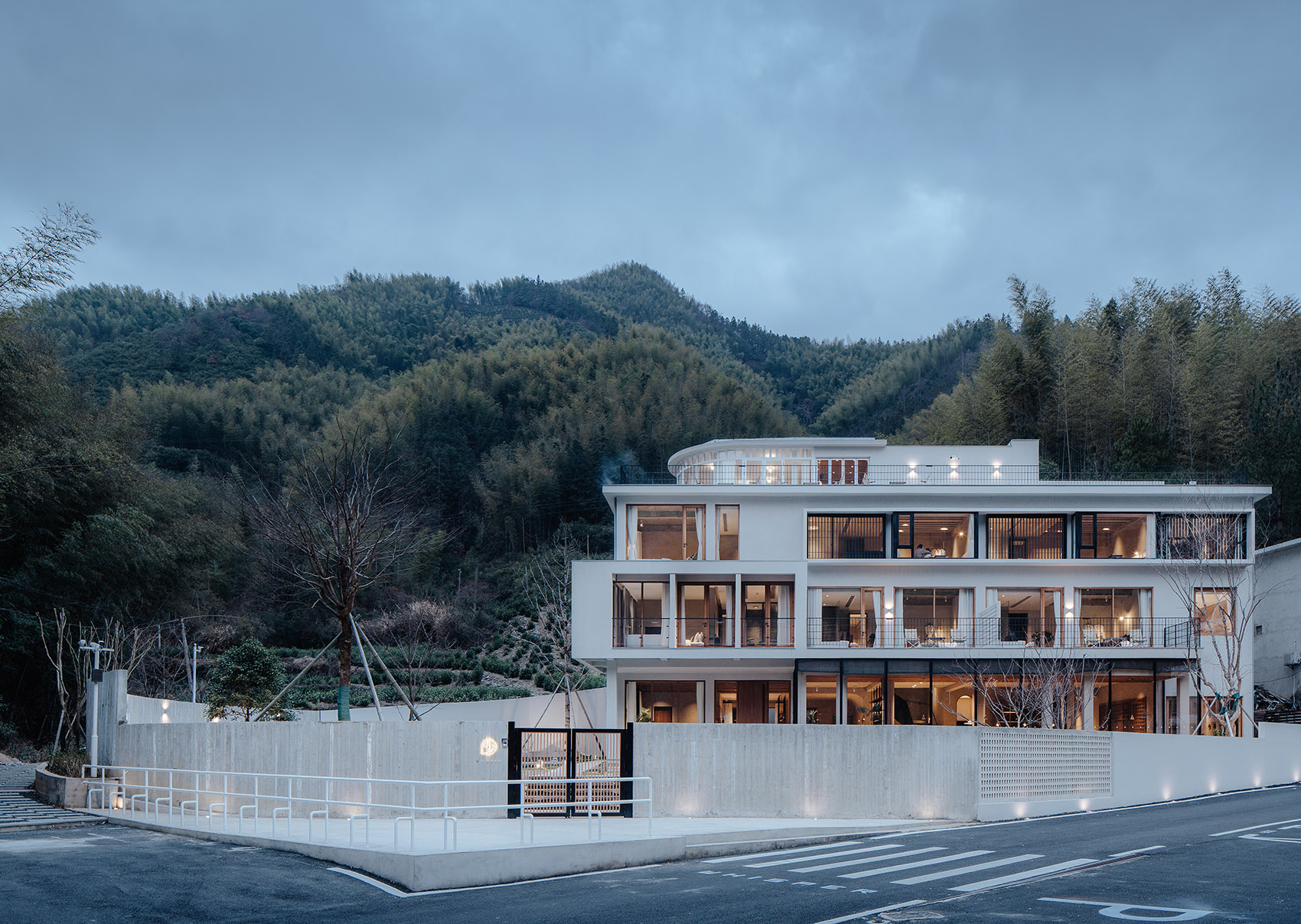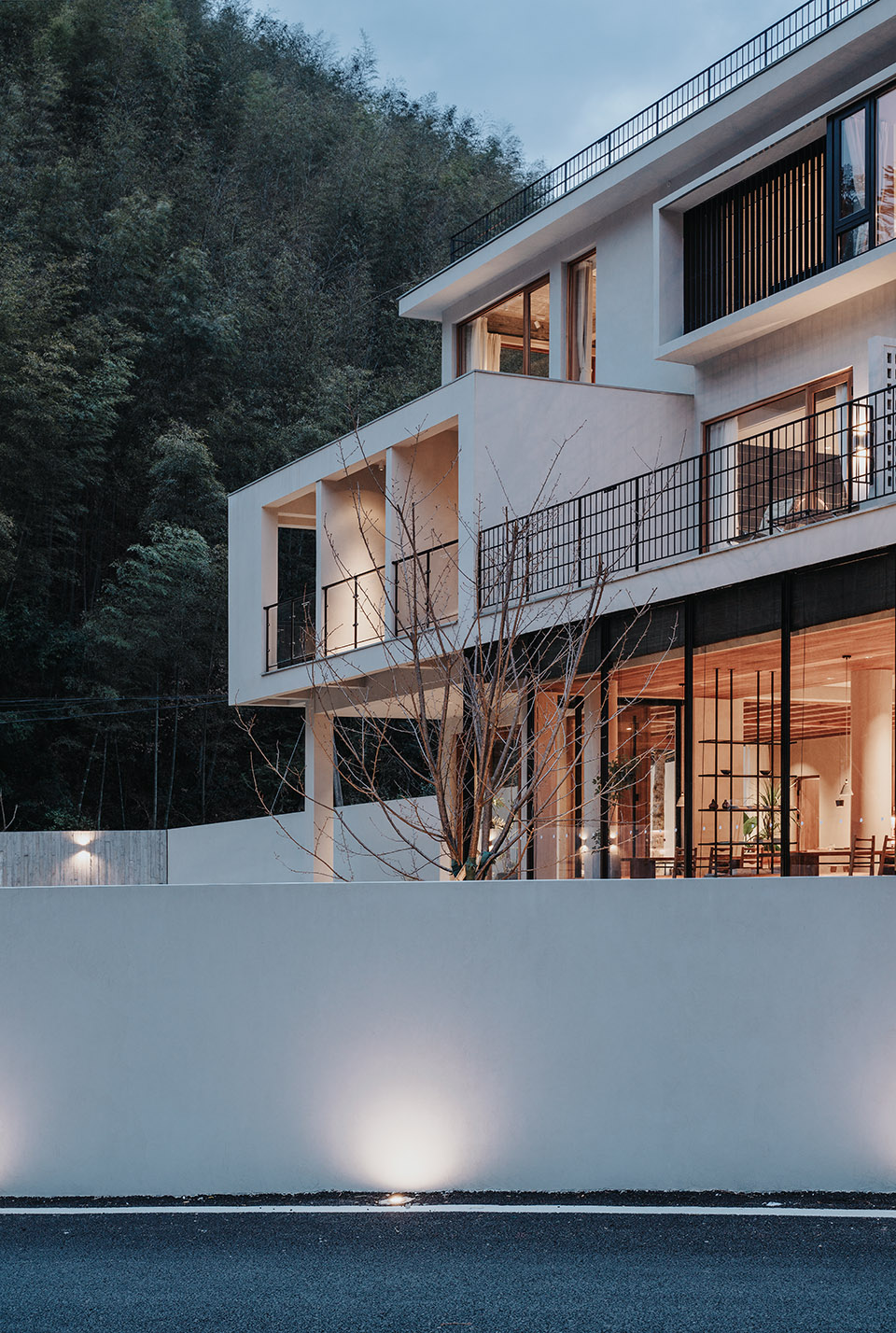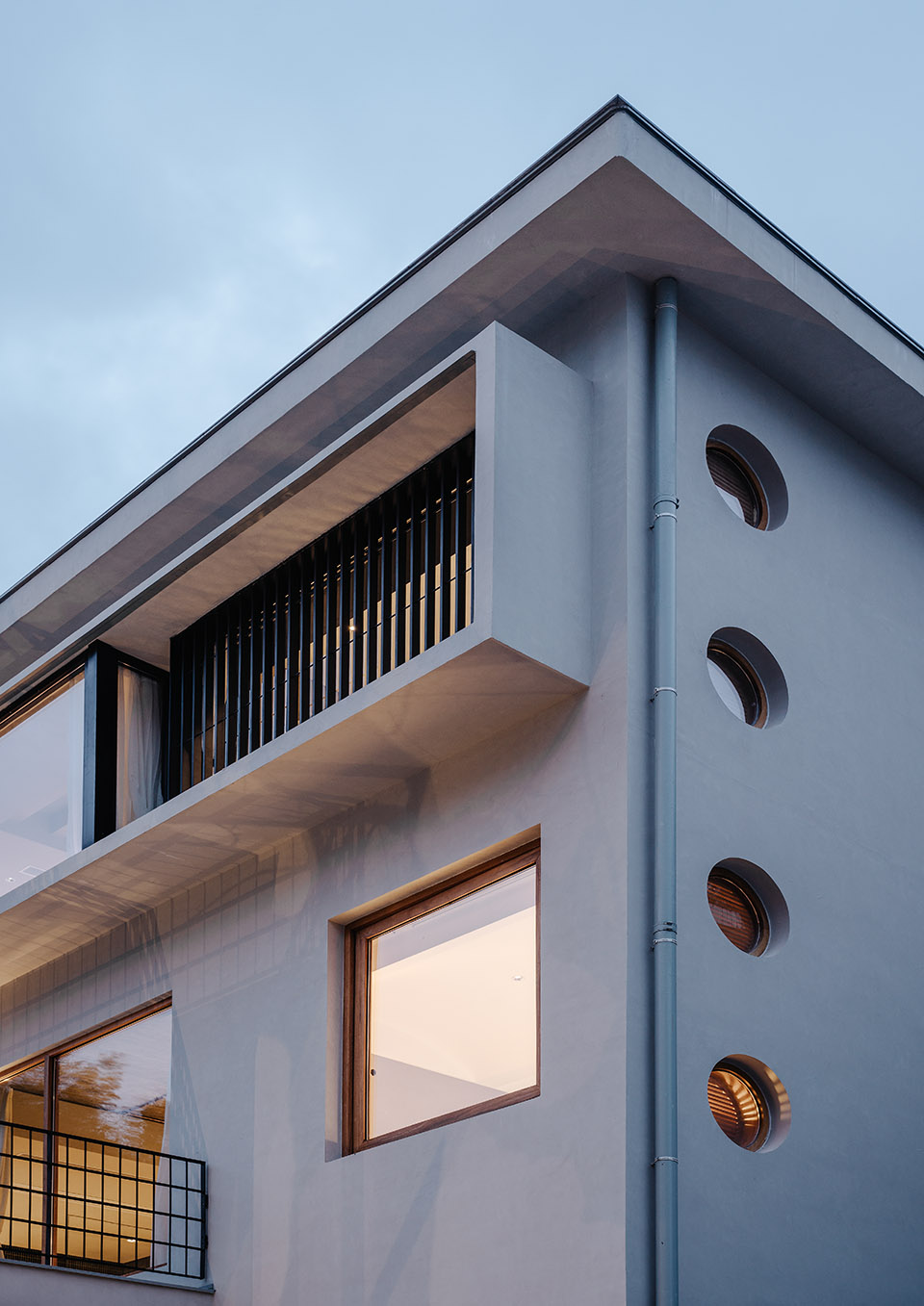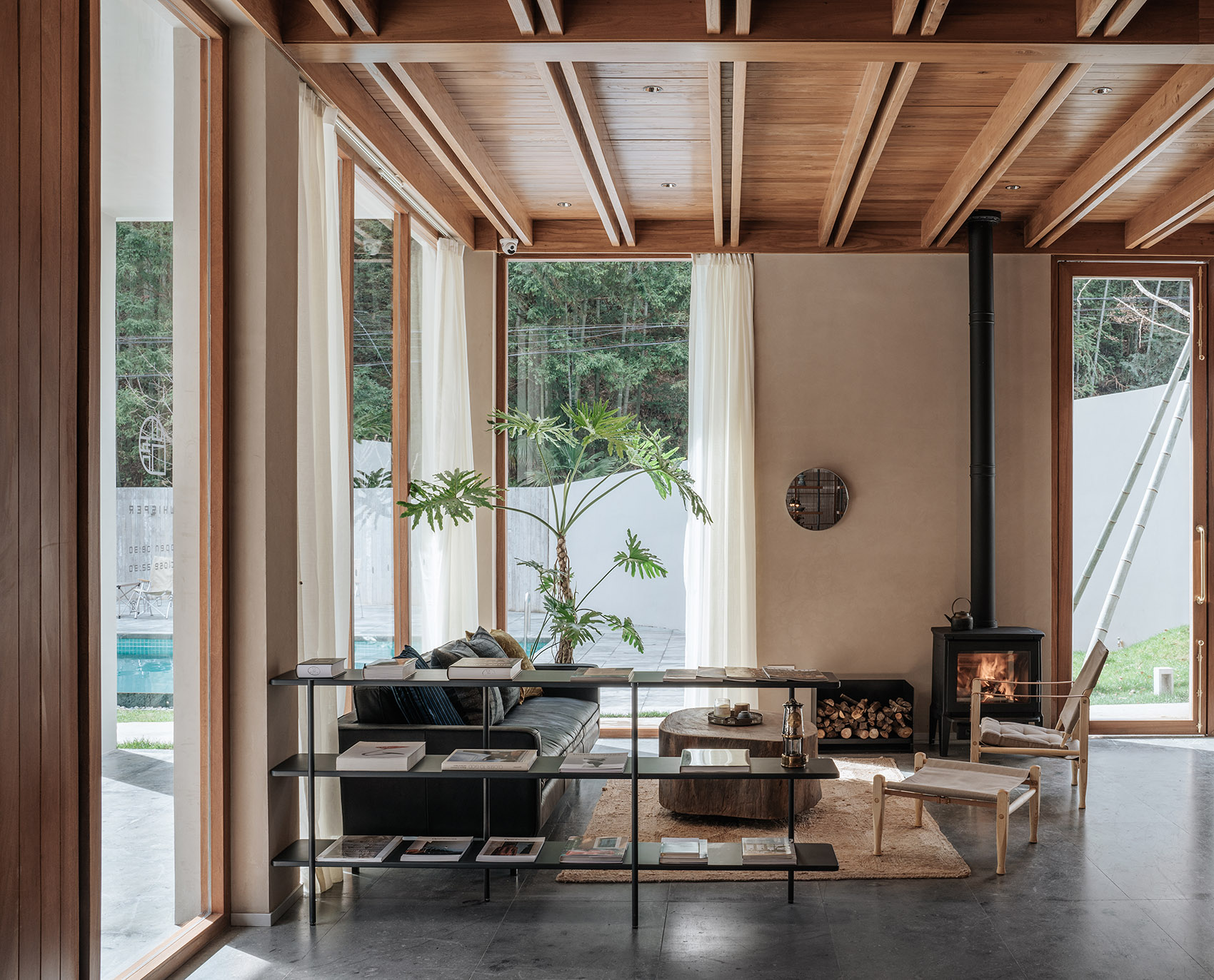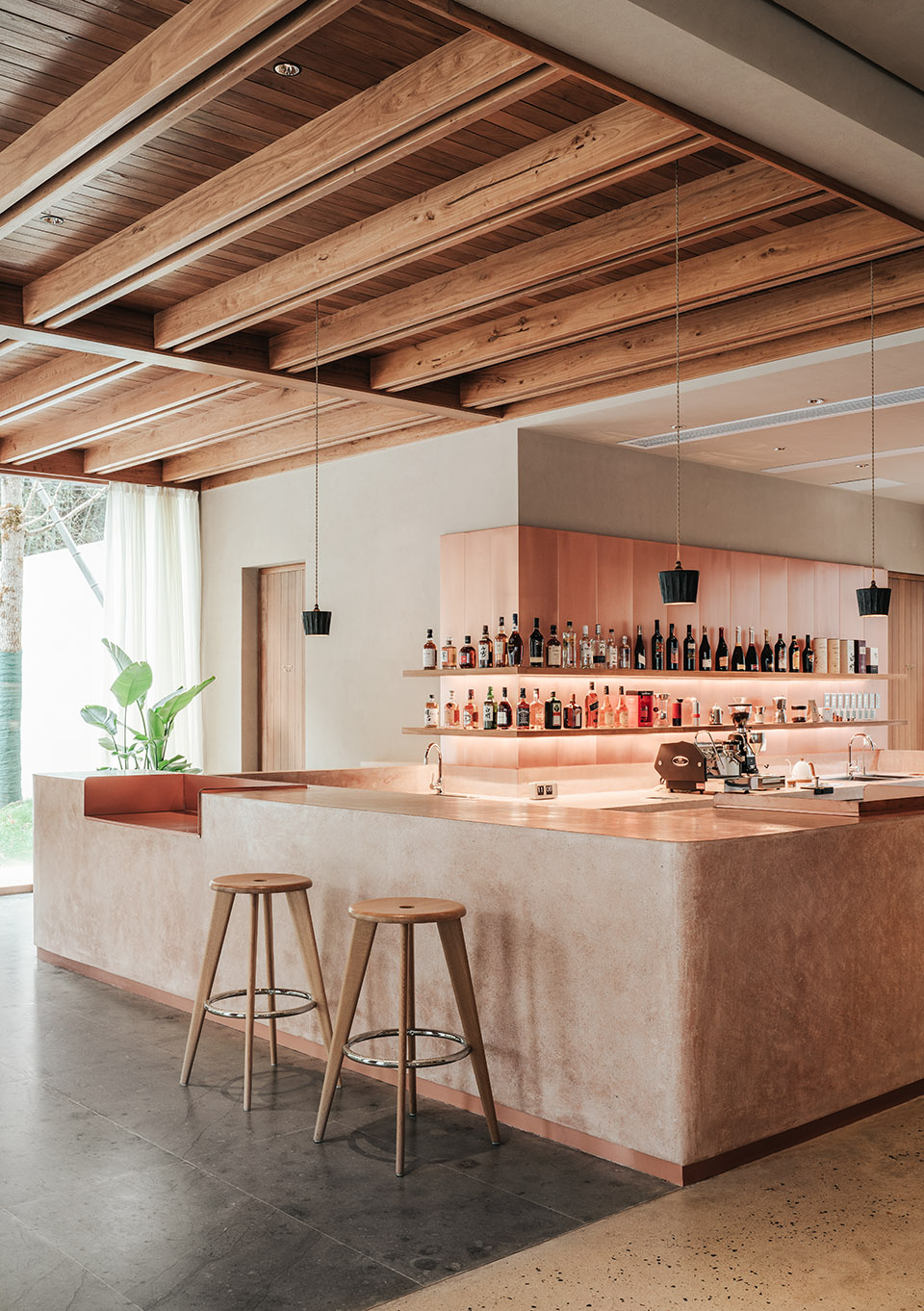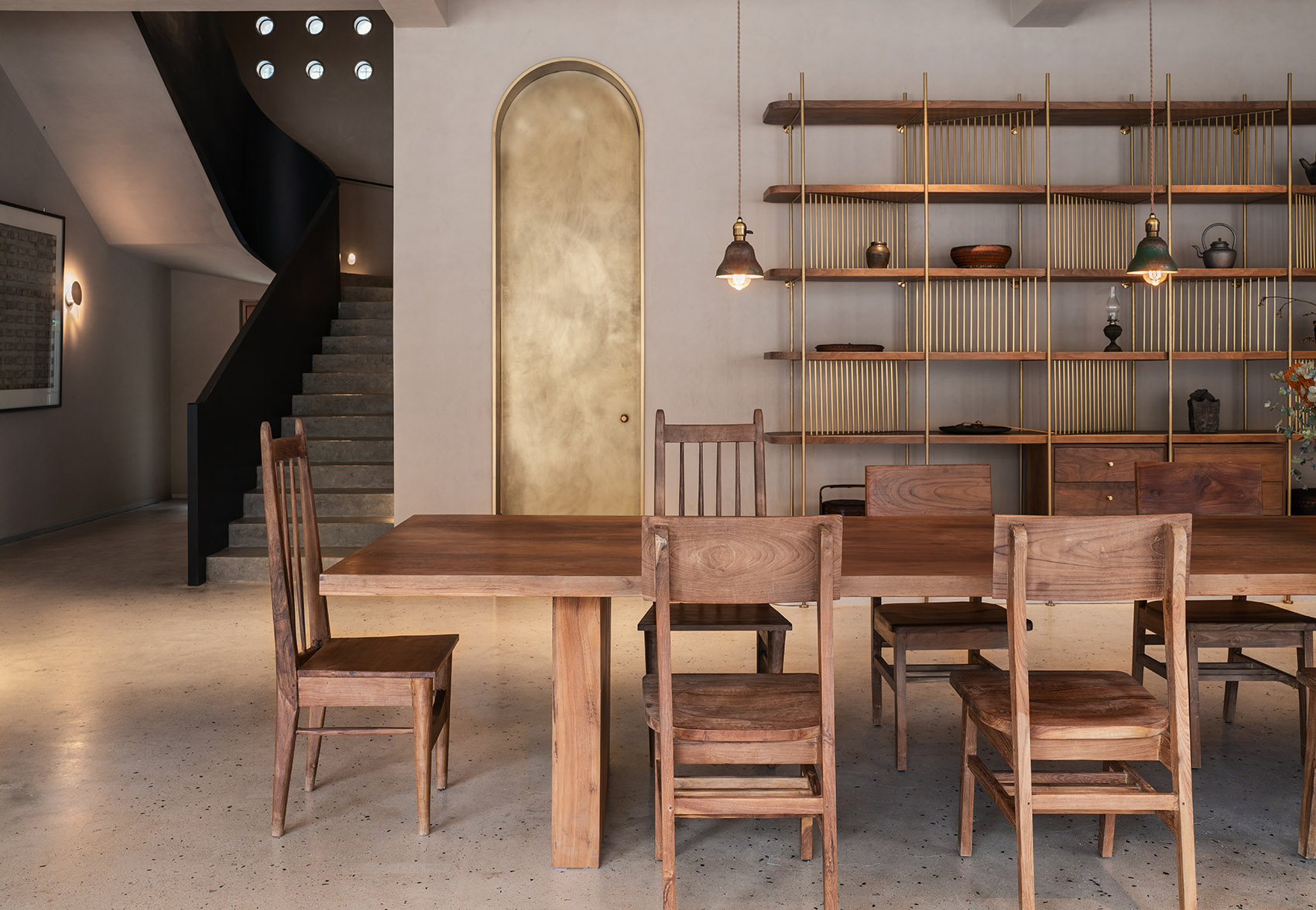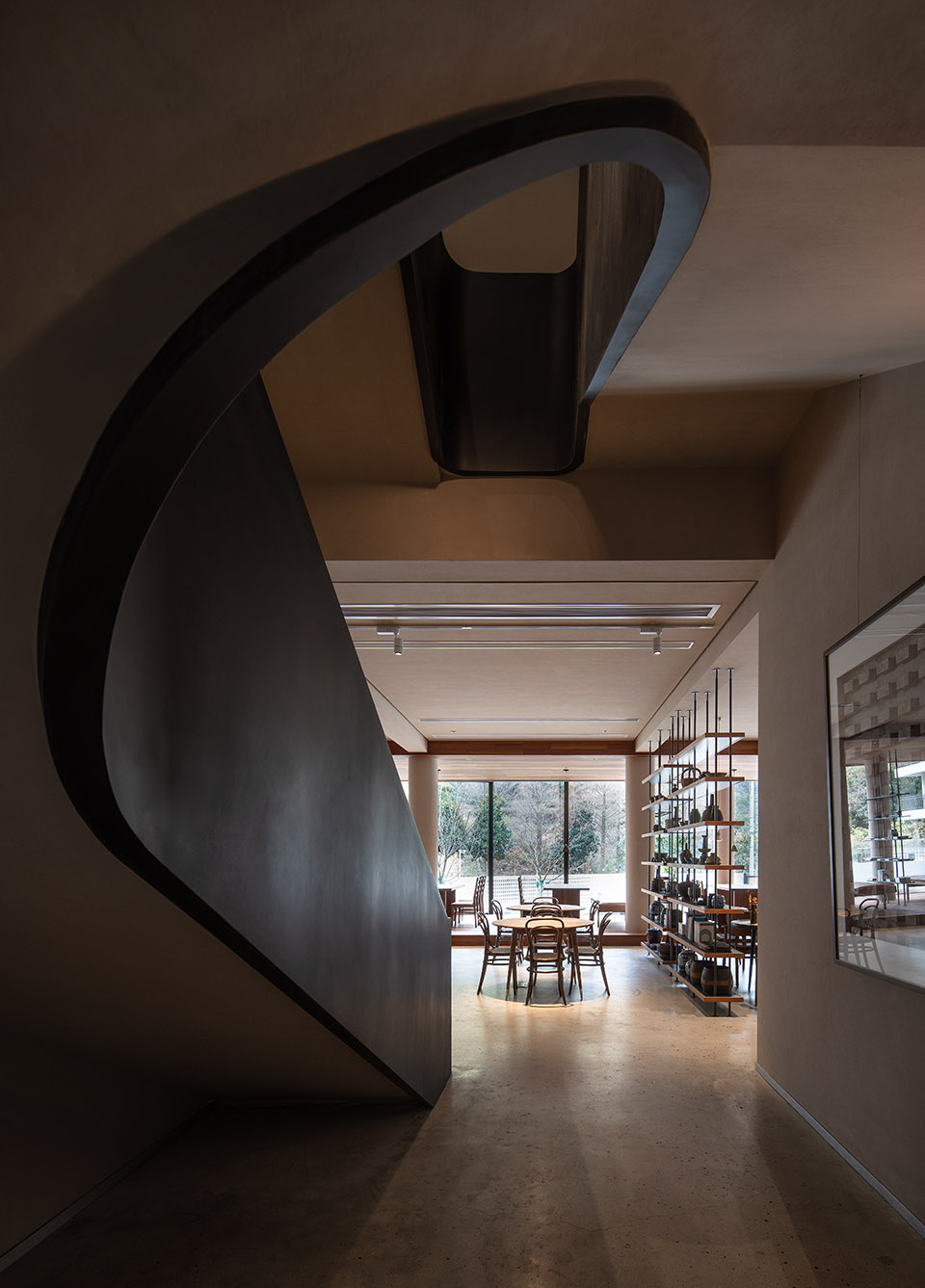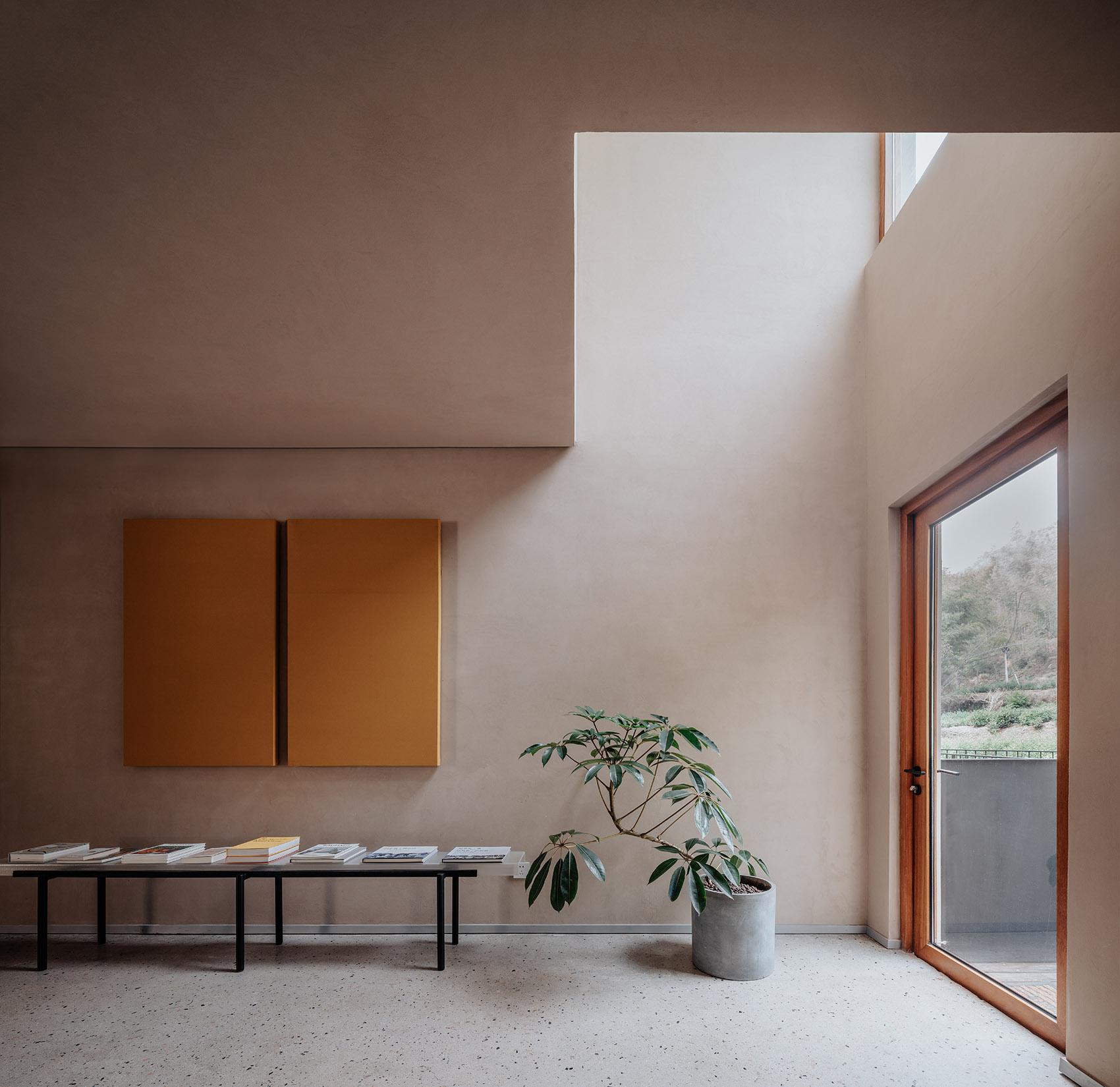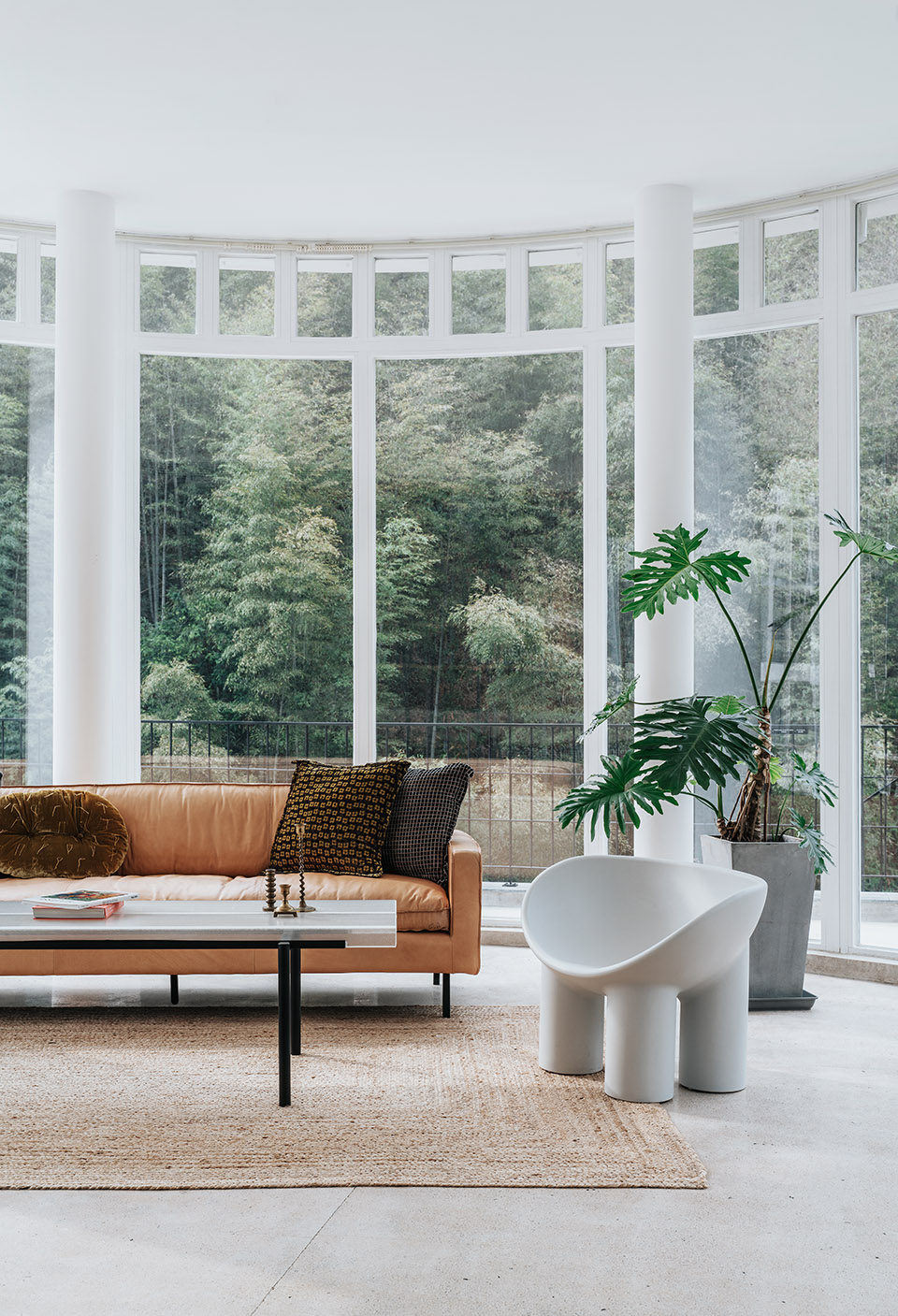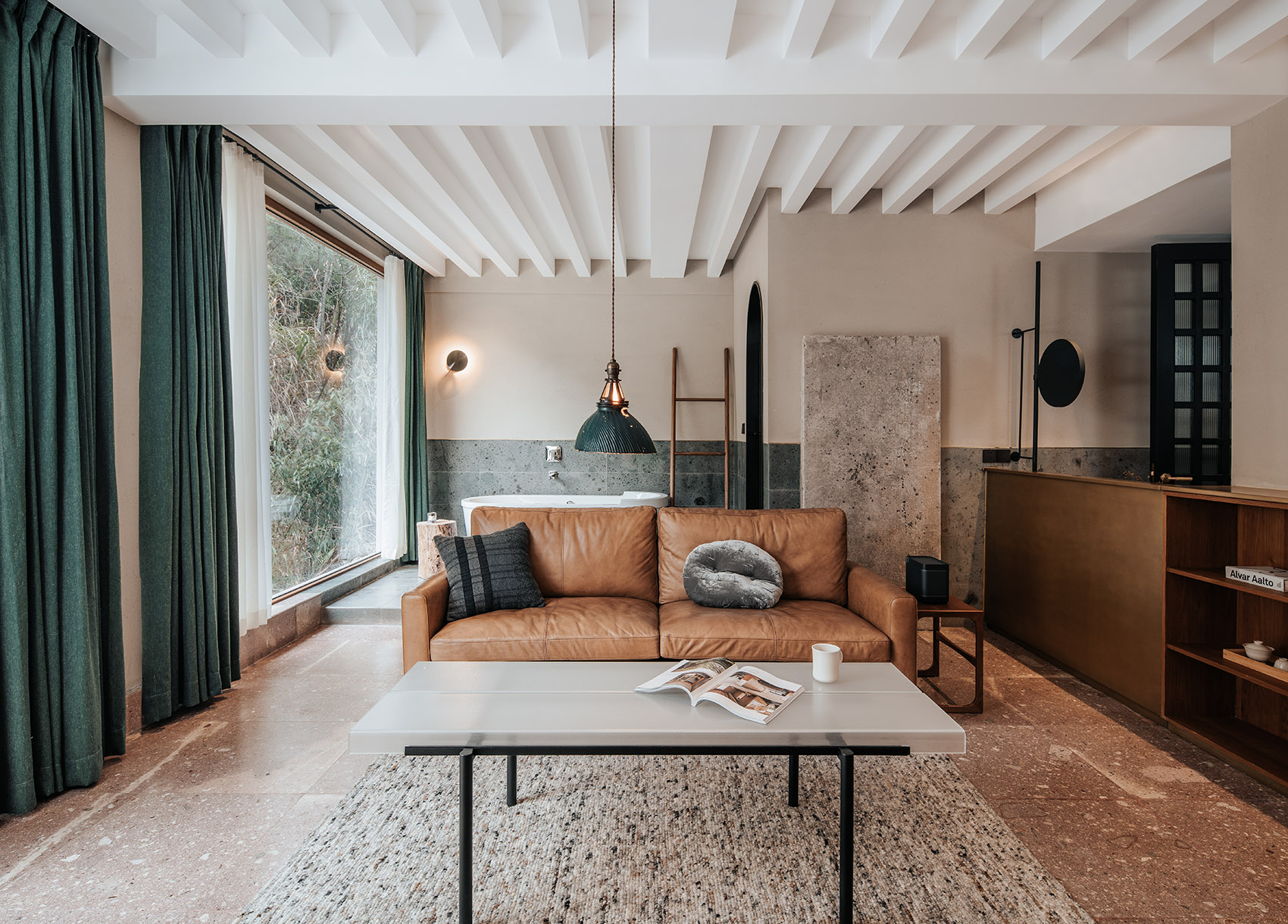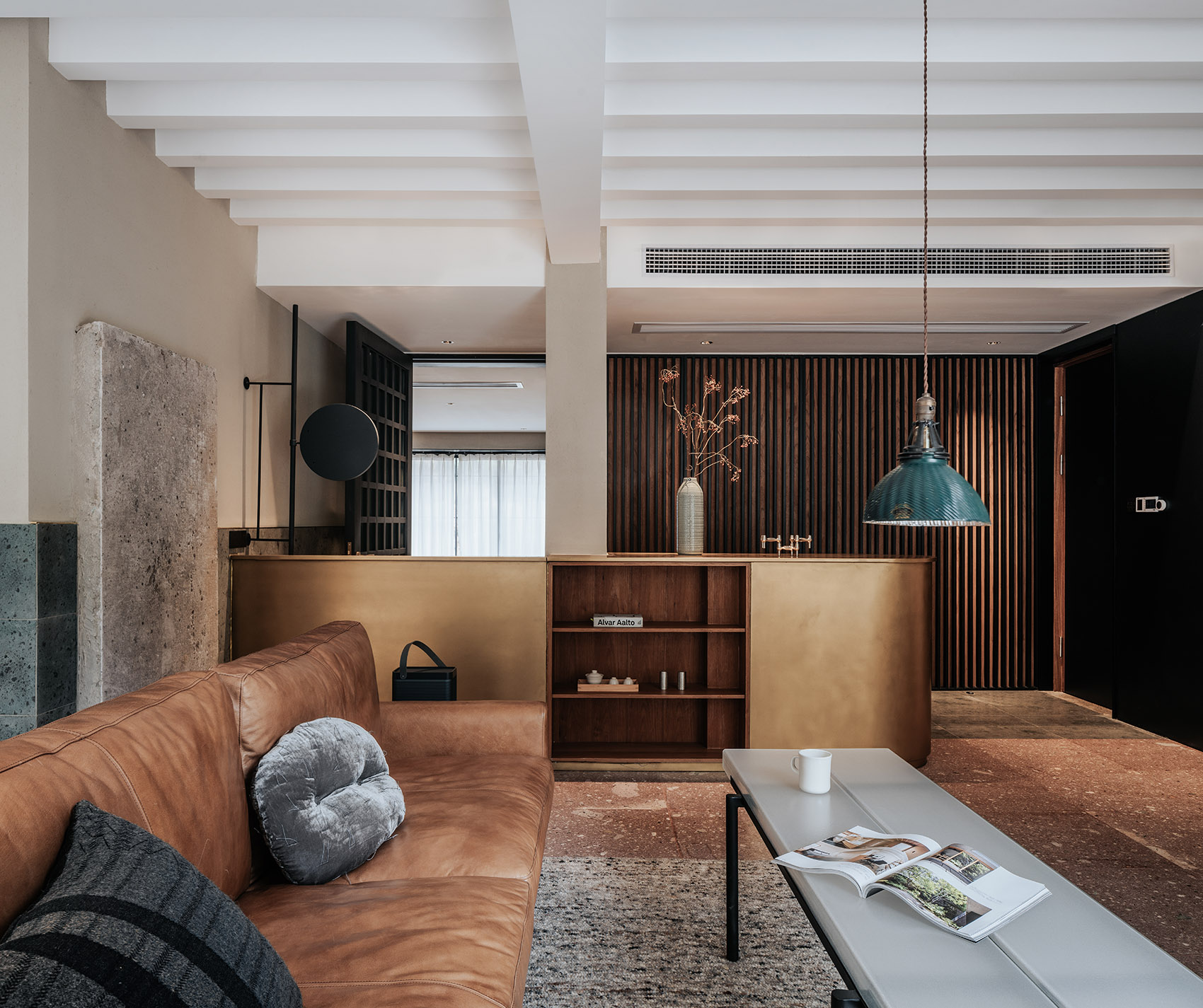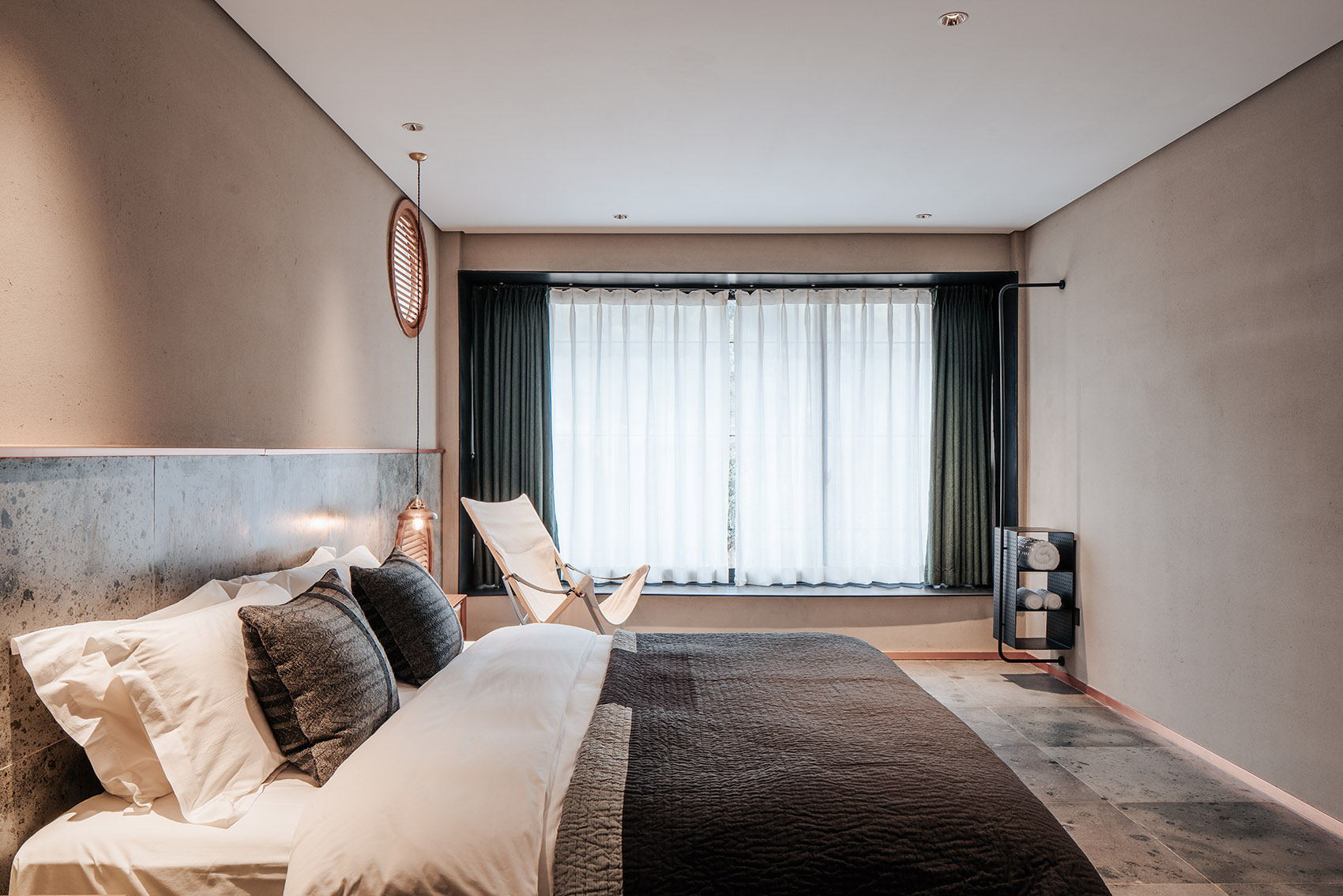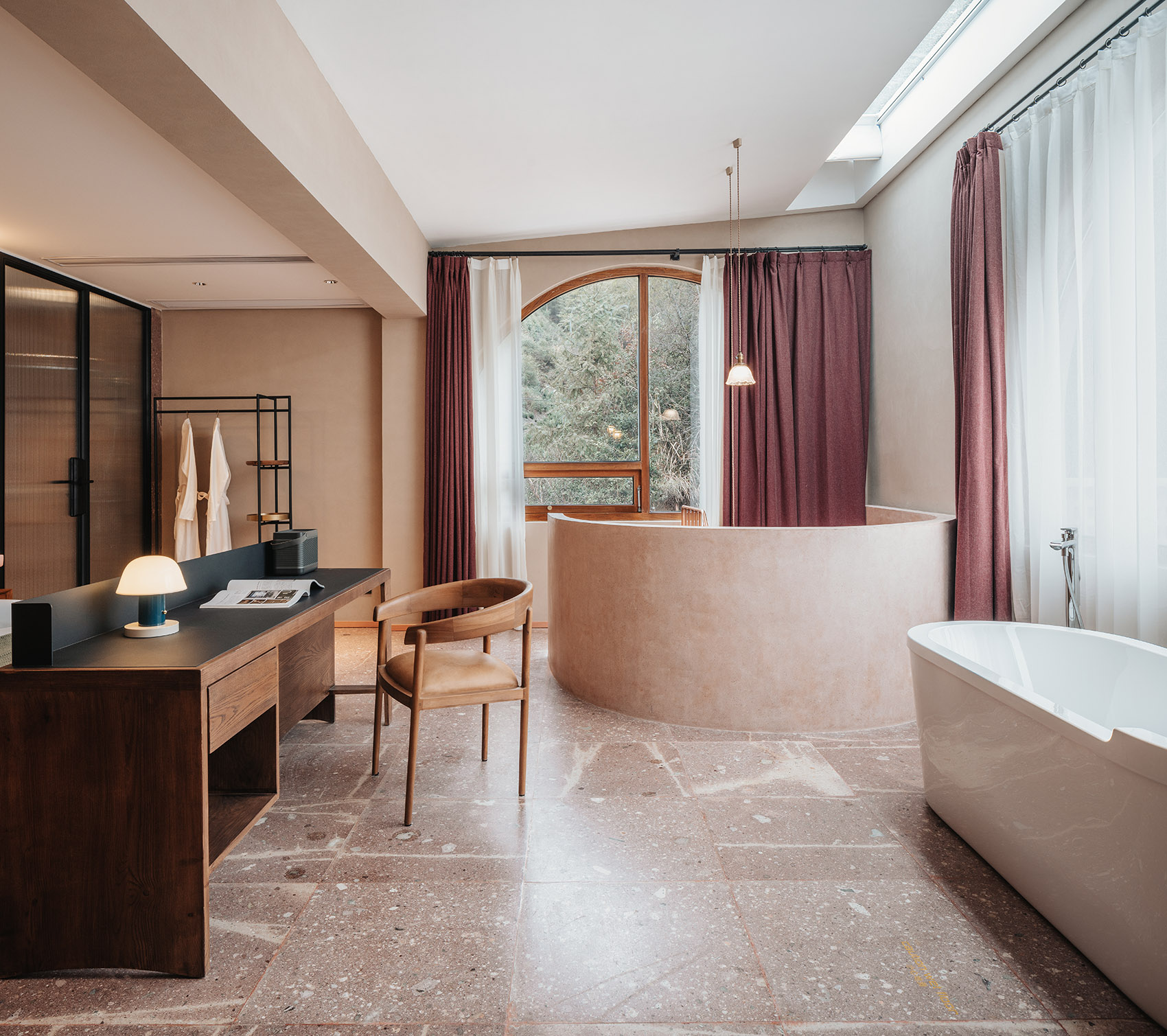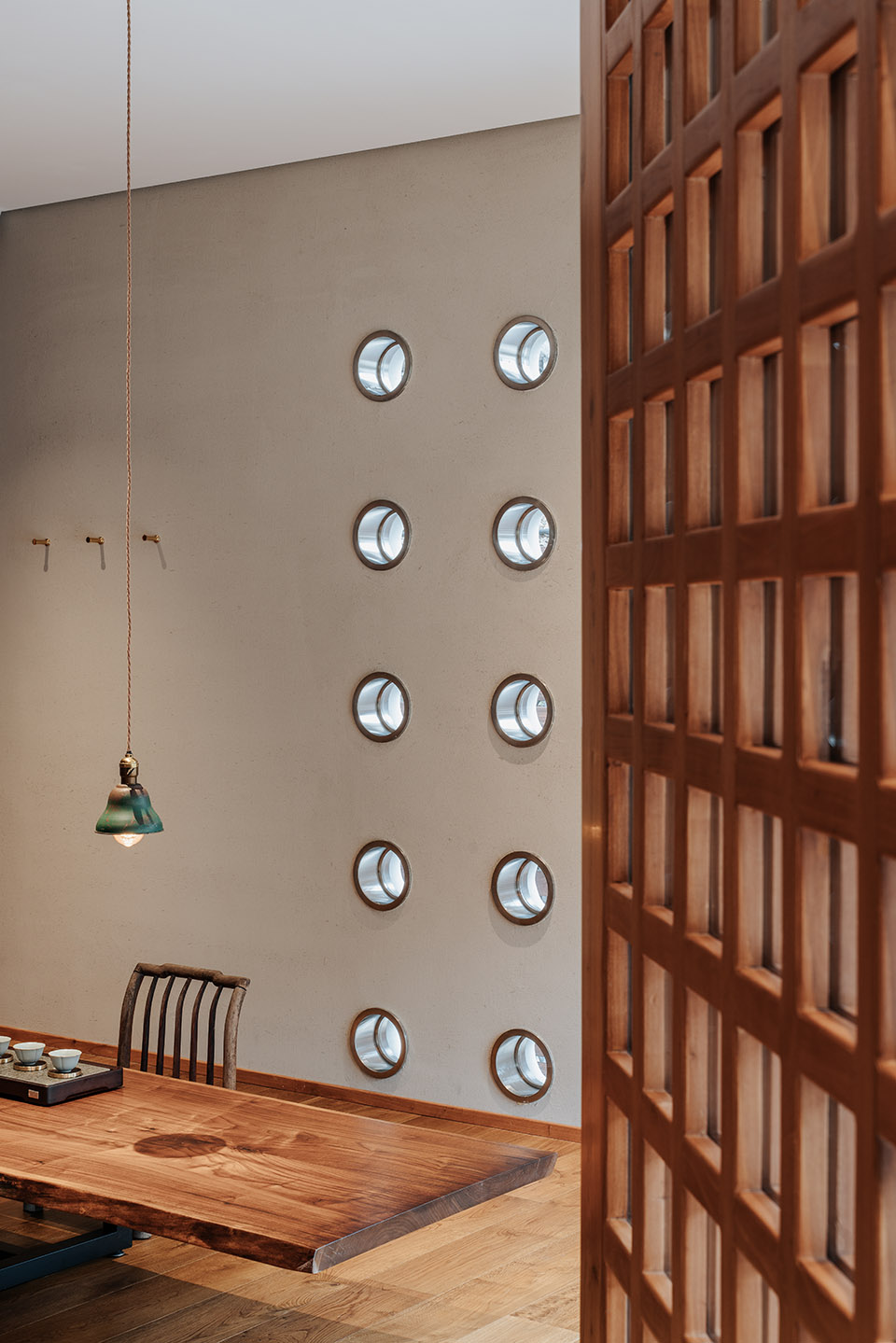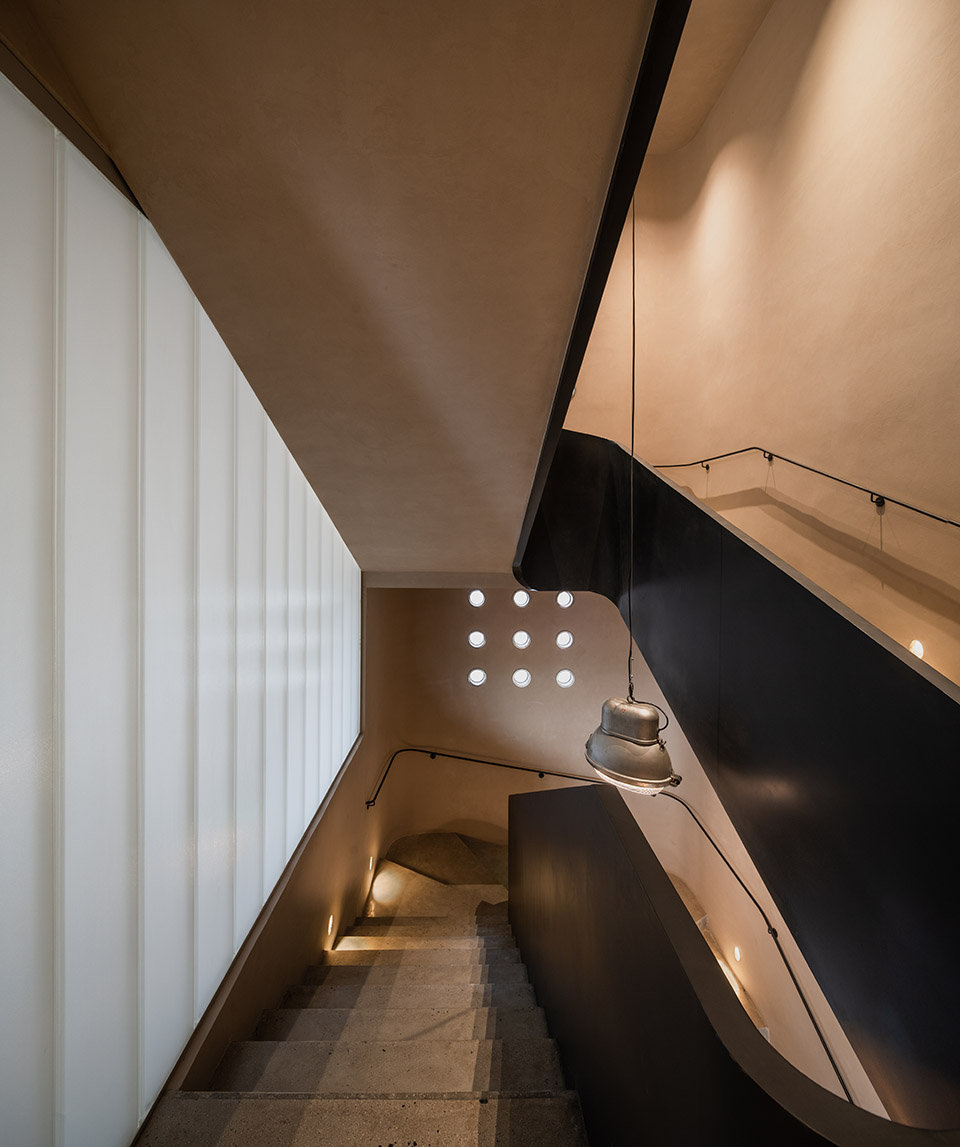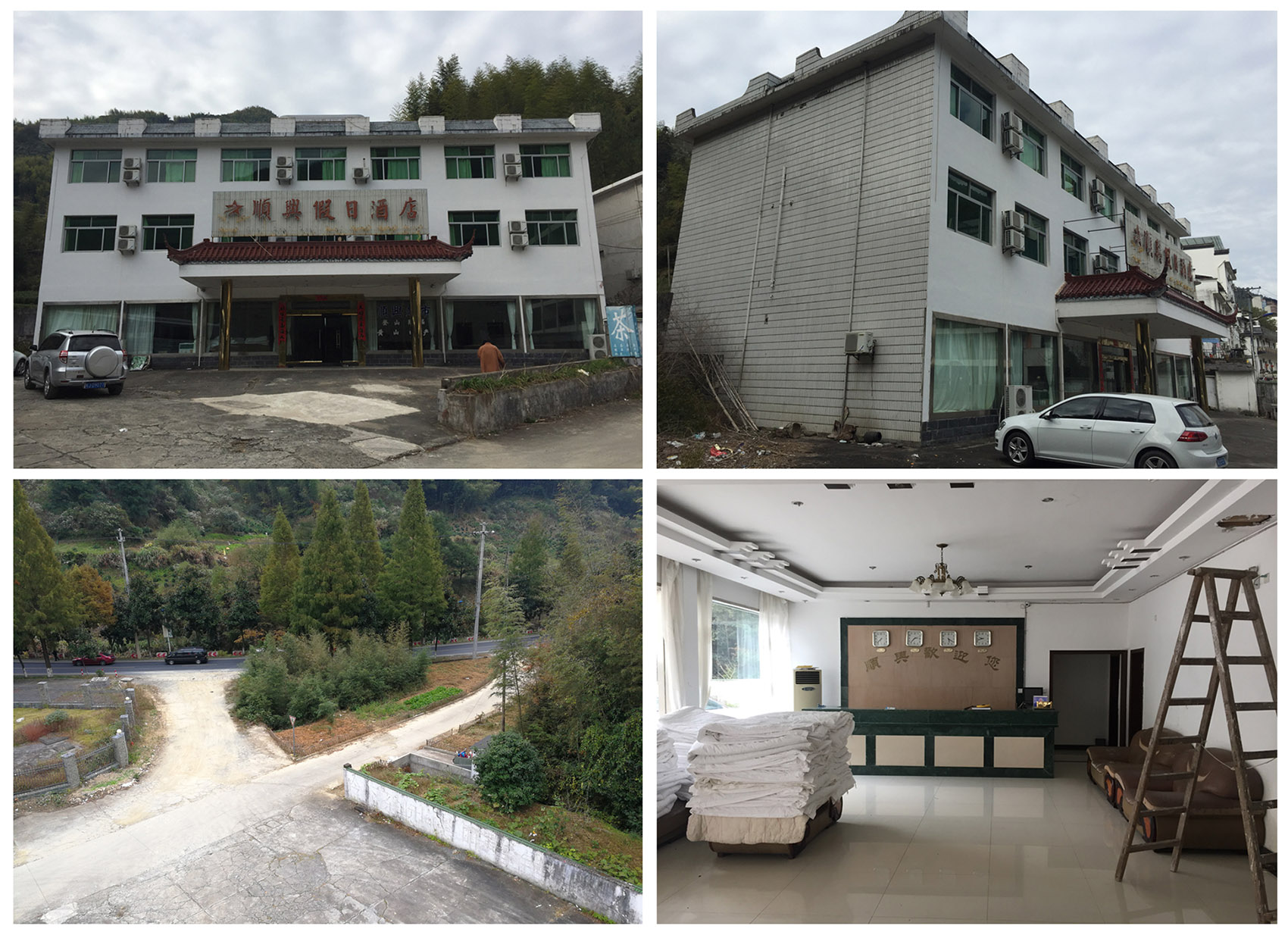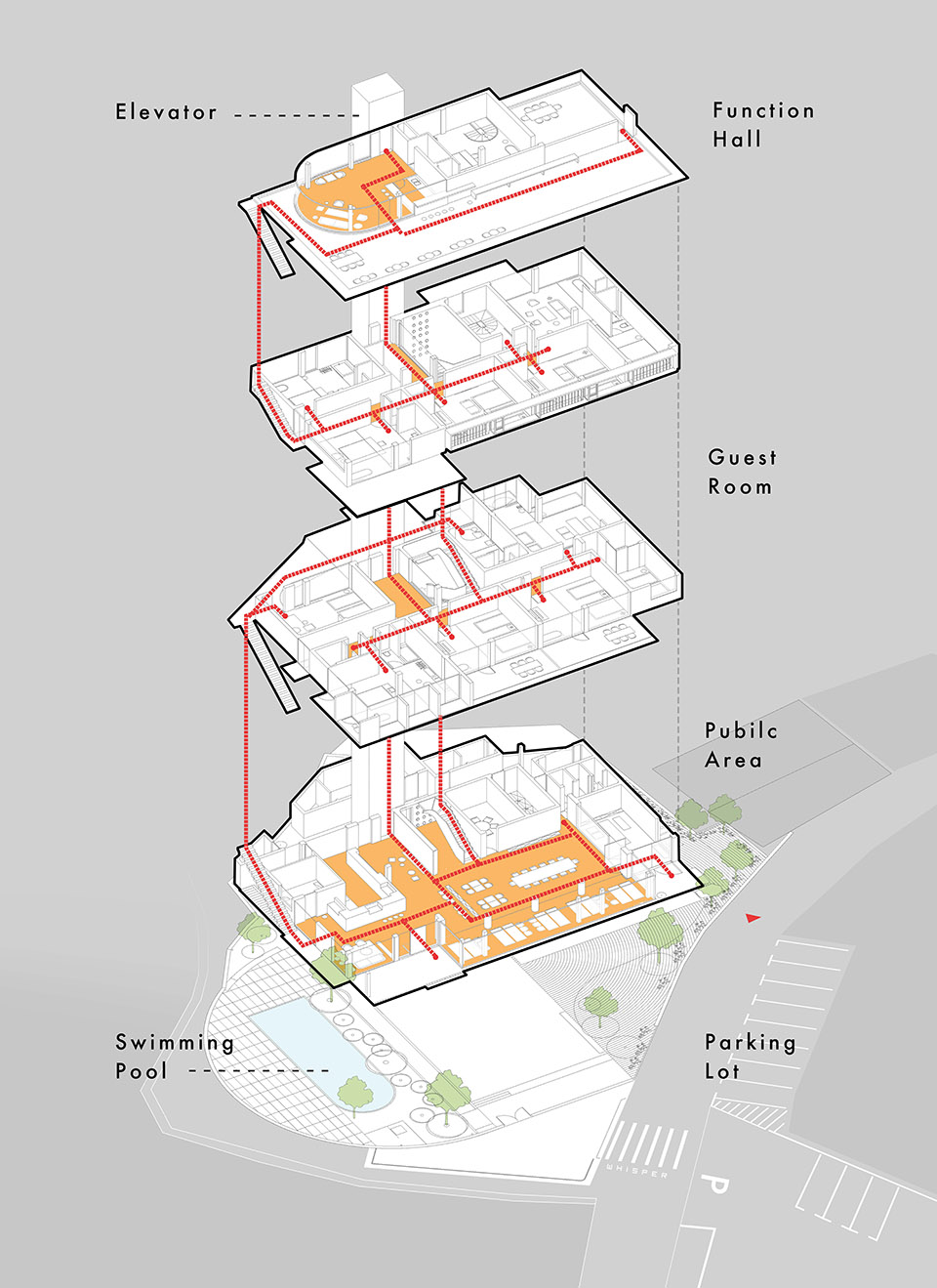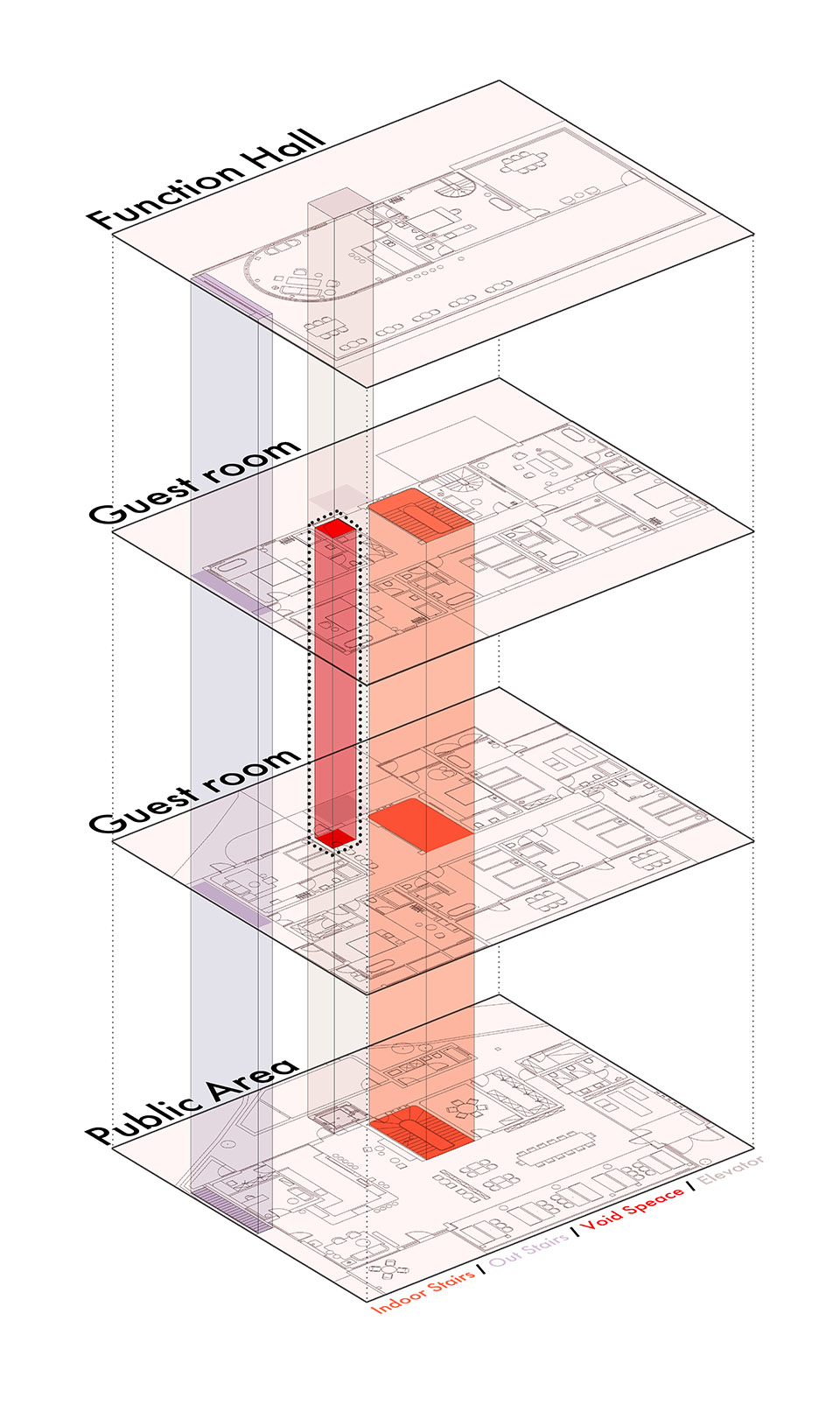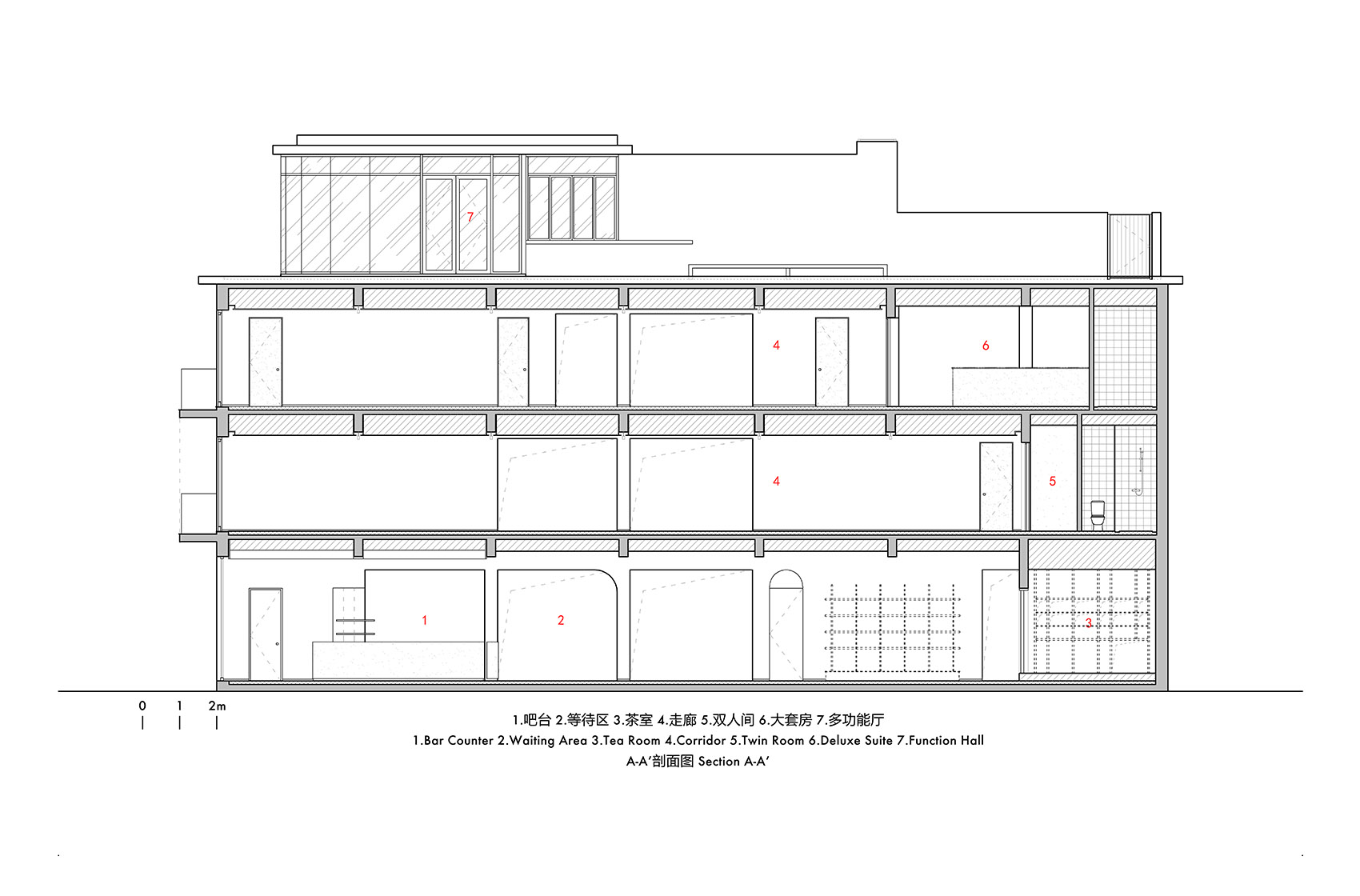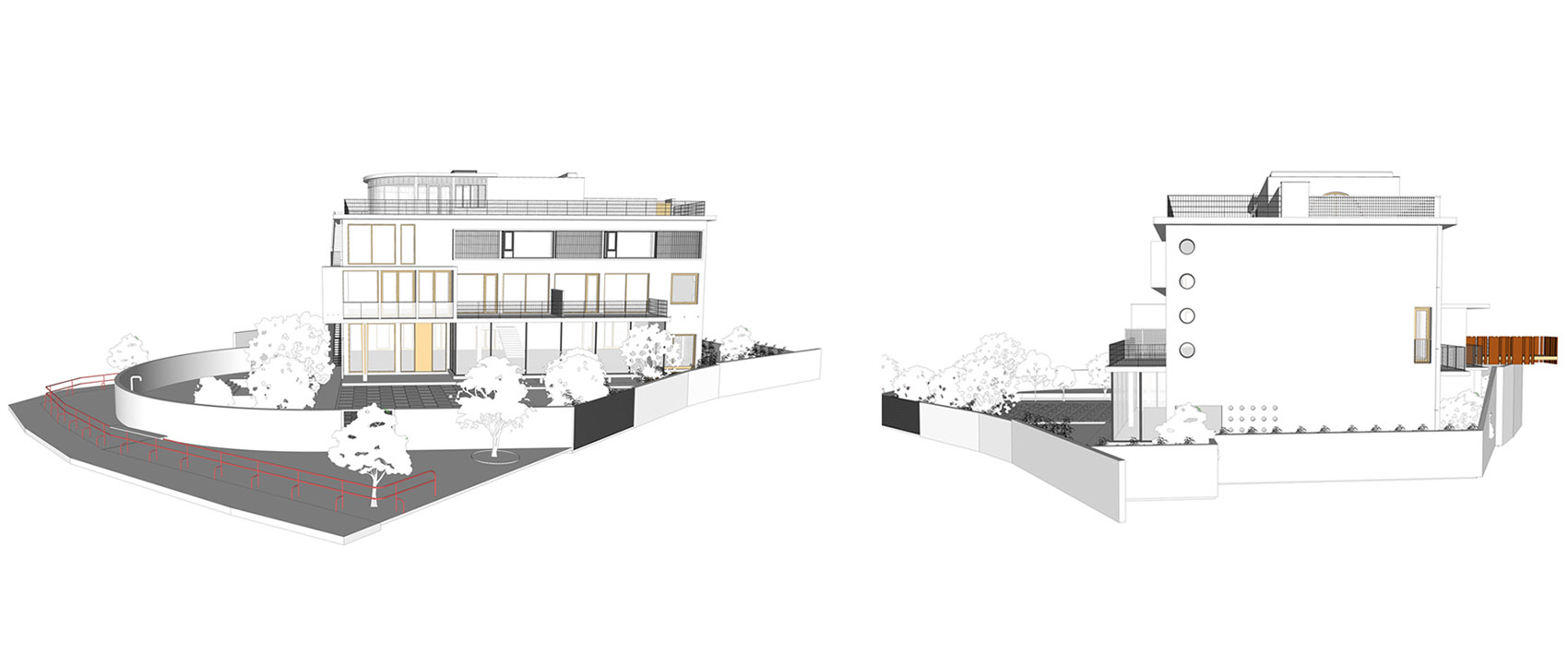汤口镇距离黄山南大门1公里是黄山的主要生活服务基地和旅游接待基地,我们改造的项目不在镇子中心地带,位于冈村小岭下1号,原建是一幢典型的老式景区酒店,建筑在整个沿路建筑群的最西侧,东南侧是冈村路视野开阔,建筑西南向面山,山下有一条溪流。原建筑东南立面庭院地块呈三角形,整个建筑的场地边界模糊。
▼鸟瞰图,aerial view ©稳摄影
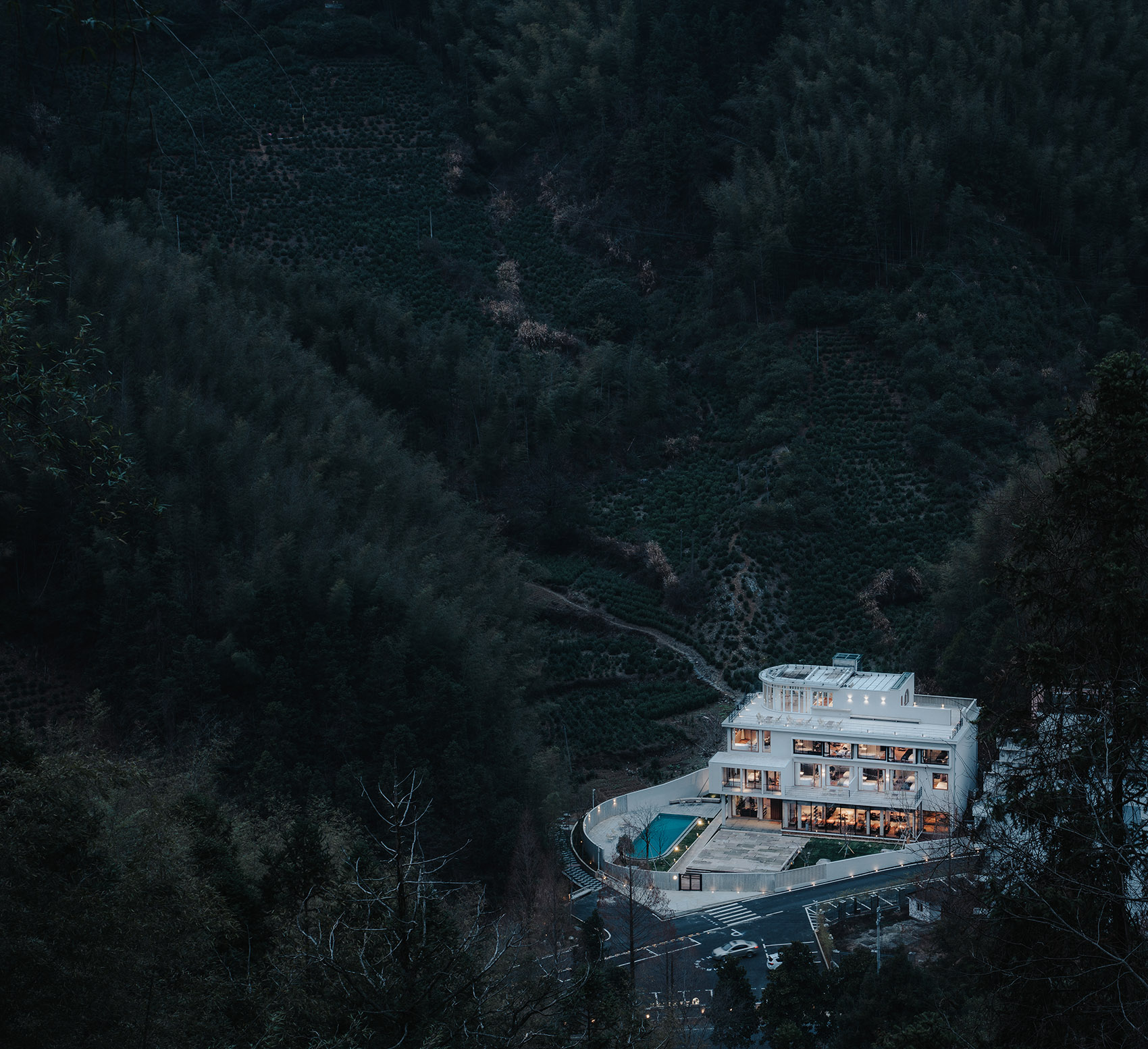
Tangkou town, 1 km long from the south gate of Mount Huangshan, is the main life service and the tourist reception base. The project to be reshaped is located at no. 1 Xiaolingxia, Gang Village. The original building is a typical old-fashioned scenic hotel and seats at the west end of the whole building complex along the road. The Gang Village Road is located in the southeast with a wide visual field. The building faces the mountains to the southwest, a stream flowing by at the foot of the mountain. The courtyard plot, situating to the southeast façade of the original, looks like a triangle, and the whole boundary of the building is blurred.
▼场地平面图,site plan ©静谧设计研究室
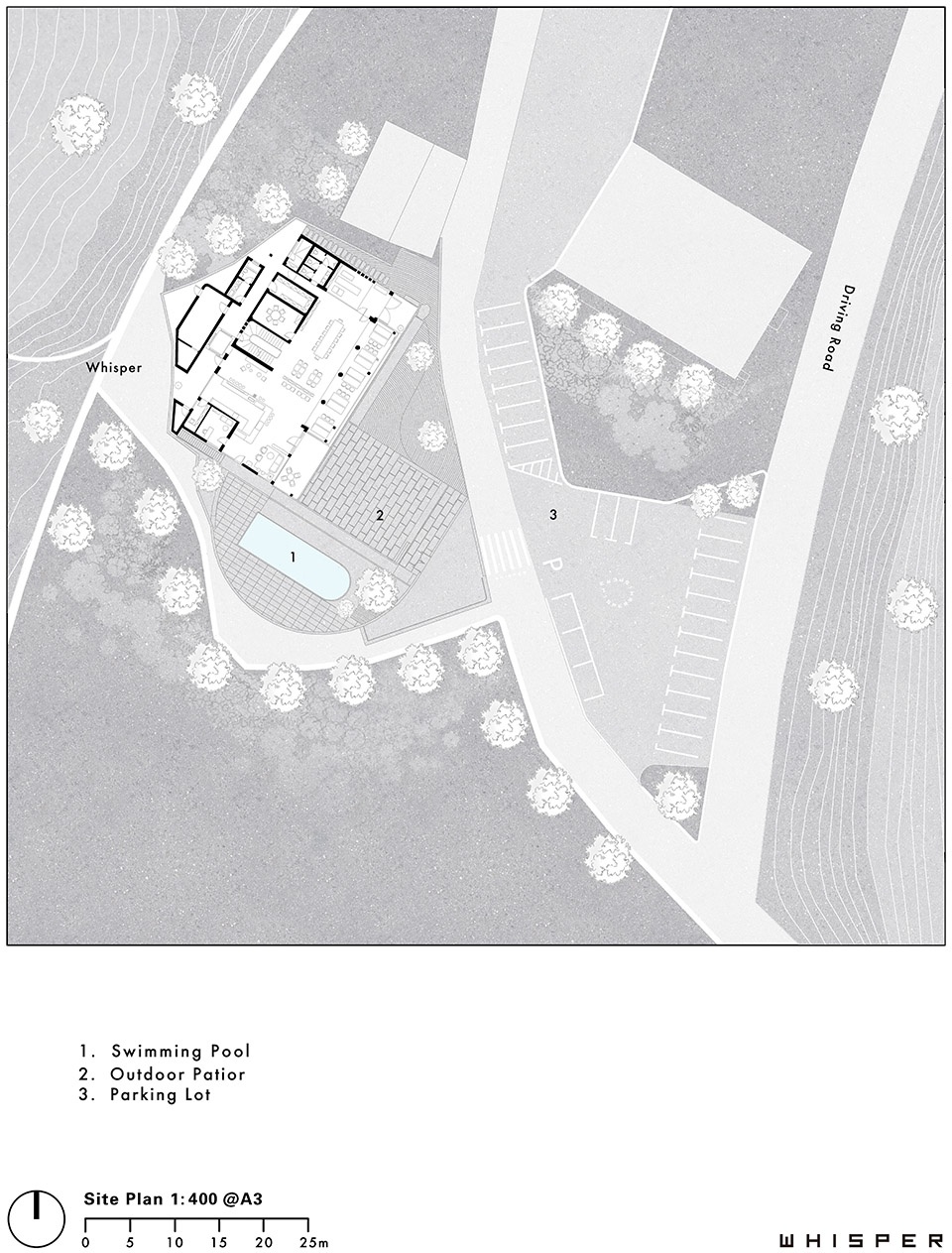
作为沿路建筑群的一部分,建筑边界除了受到道路走向的影响外,还有一部分边界的形成来自周边自然景观相互挤压。在建筑庭院外面是由北向南下坡的乡道,停车场用地在乡道的另一侧,在初期测量阶段由于地面是硬化坡面高差的问题很容易被忽略掉,实际上建筑室内地面与乡道的相对高差接近1.5米,这个相对高差对于建筑空间的二次塑造很重要。
原本的建筑内部空间虽然是以住宿来规划的,但是过于单一的户型和高密度的房间数量导致房间的采光不佳和紧凑的卫生间面积,已经不再符合当下的住宿要求。在建筑外立面首先要剔除的是元素形式拼贴部分,包括阳台的琉璃瓦装饰部件和顶楼的长城墙造型扶手,以及巨大的酒店门头部分,去掉这些拼贴元素回归空间的表达,另外对室内外关系的整体梳理,其实建筑空间的重塑才是最好的表达。
As part of the building groups along the road, some buildings are affected by the road direction on their boundaries, and other boundaries are formed owing to the surrounding natural landscape that they encroach on each other’s space. Outside the garden is a country road from north to south and on the other side of the road lies the parking lot. It is apt to overlook the height difference in the process of initial measurement, due to the hardened slope as the ground, while actually, the relative height difference between the interior floor of the upper building and the road is approximately 1.5 meters, which is an essential factor for the reshaping of architectural space.
Although interior space of the building was originally planned for living, it doesn’t meet the current accommodation requirements, as the unified flat planning design and high-density rooms result in bad daylighting and narrow washroom space. As for external façade of the building, the first thing we should do is to remove element collage, including glazed tile decoration of the balcony and the long wall of the armrest at the top floor, and the huge hotel door-head, for space expression. Beyond this, remodeling architectural space is the best for overall arrangement of indoor and outdoor spaces.
▼改造前原貌,the existing building

如何实现可控的边界?在这次改造设计过程中一直被重复探讨的问题。在总平面功能布置设计中,有一个绕不开的部分就是呈三角形的庭院,这样导致不管在庭院还是在室内往实体边界外看的时候总是有一个夹角形成的区域,我们采取的设计思路是弱化三角区域的视觉存在感,首先将庭院的入门设计在与建筑平行的切线上,让三角区域的部分被压缩到最小的状态也是高差处理最低矮的部分,另外引入一个半圆的弧线和建筑的平行切线形成一个整体,后期建造的现浇混凝土围墙以镶嵌的方式置入场地,衔接到两侧原有的围墙。围墙作为一种边界的实体,我们希望与建筑的关系呈现一种低矮的状态,为了让停车场与建筑主体保持更多联系,我们预留了一部分格栅方孔隔墙,材质同现浇的围墙一样,在强化边界的同时保证视觉外延。
In the transformation designing, a problem has been repeatedly proposed, that is “how to make sure the boundary is manageable?” It is inevitable to discuss the triangular courtyard when we are considering the functional layout and design of the general plane. Thus, whether from the courtyard or the interior to the outside of the physical boundary, you will always see an area formed by an Angle. Our idea is to weaken its visual presence. Firstly, the entrance to the courtyard is positioned on a tangent parallel to the building, so that the triangular region is shrunk to an extreme, namely, it is the lowest part in height difference treatment. In addition, a semicircular arc is added to work in concert with parallel tangents of the building. The cast-in-situ concrete bounding wall is embedded into the site and connected with the existing walls on both sides. As a material boundary, the bounding wall is expected to be well-proportioned together with buildings. We reserve a portion of the grille square partition made of material the same as the cast-in-situ bounding wall, enhancing boundaries while maintaining the visual extension.
▼庭院的入门设计在与建筑平行的切线上, the entrance to the courtyard is positioned on a tangent parallel to the building ©稳摄影
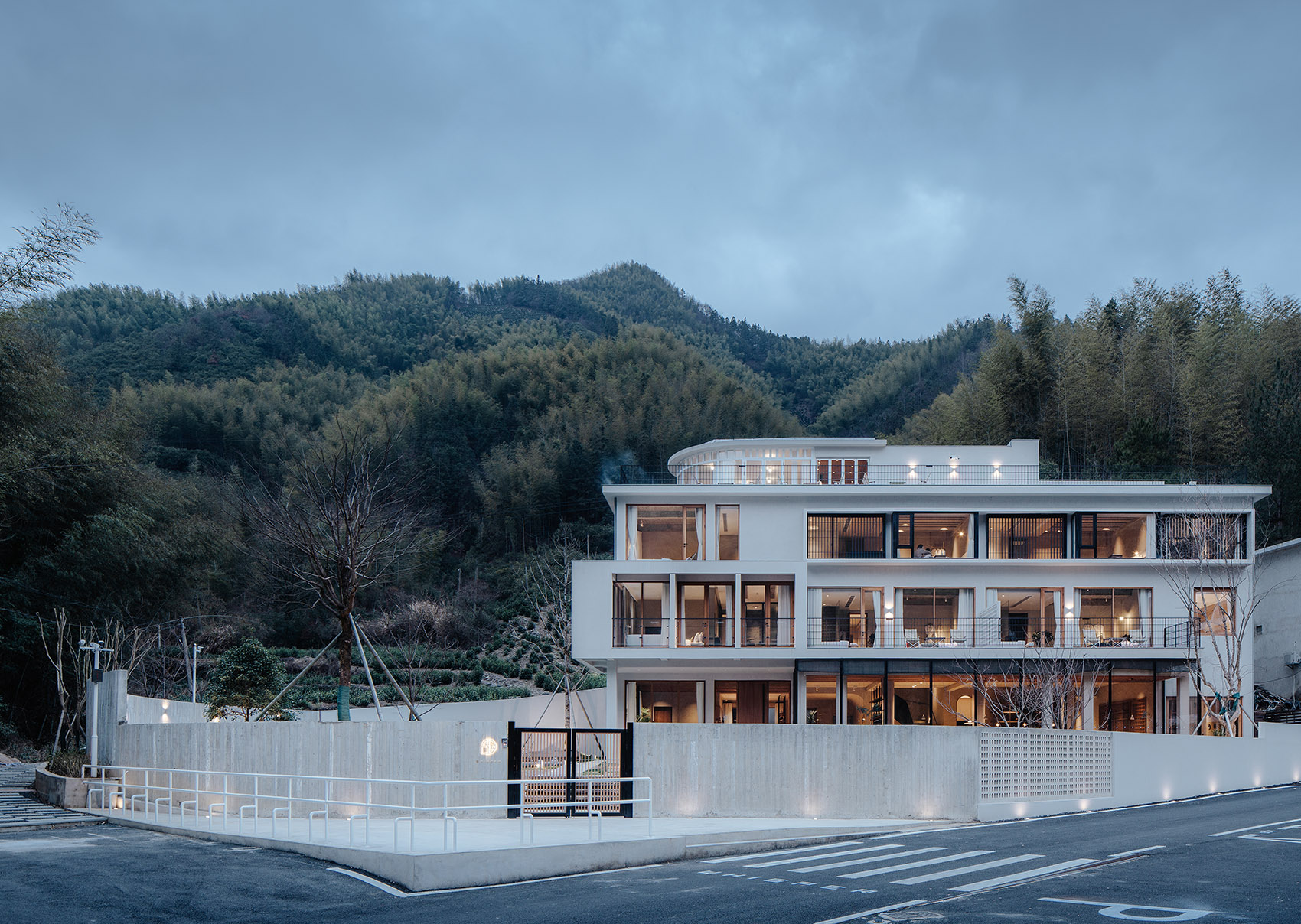
▼格栅方孔隔墙在强化边界的同时保证视觉外延, the grille square partitions enhance boundaries while maintaining the visual extension ©稳摄影
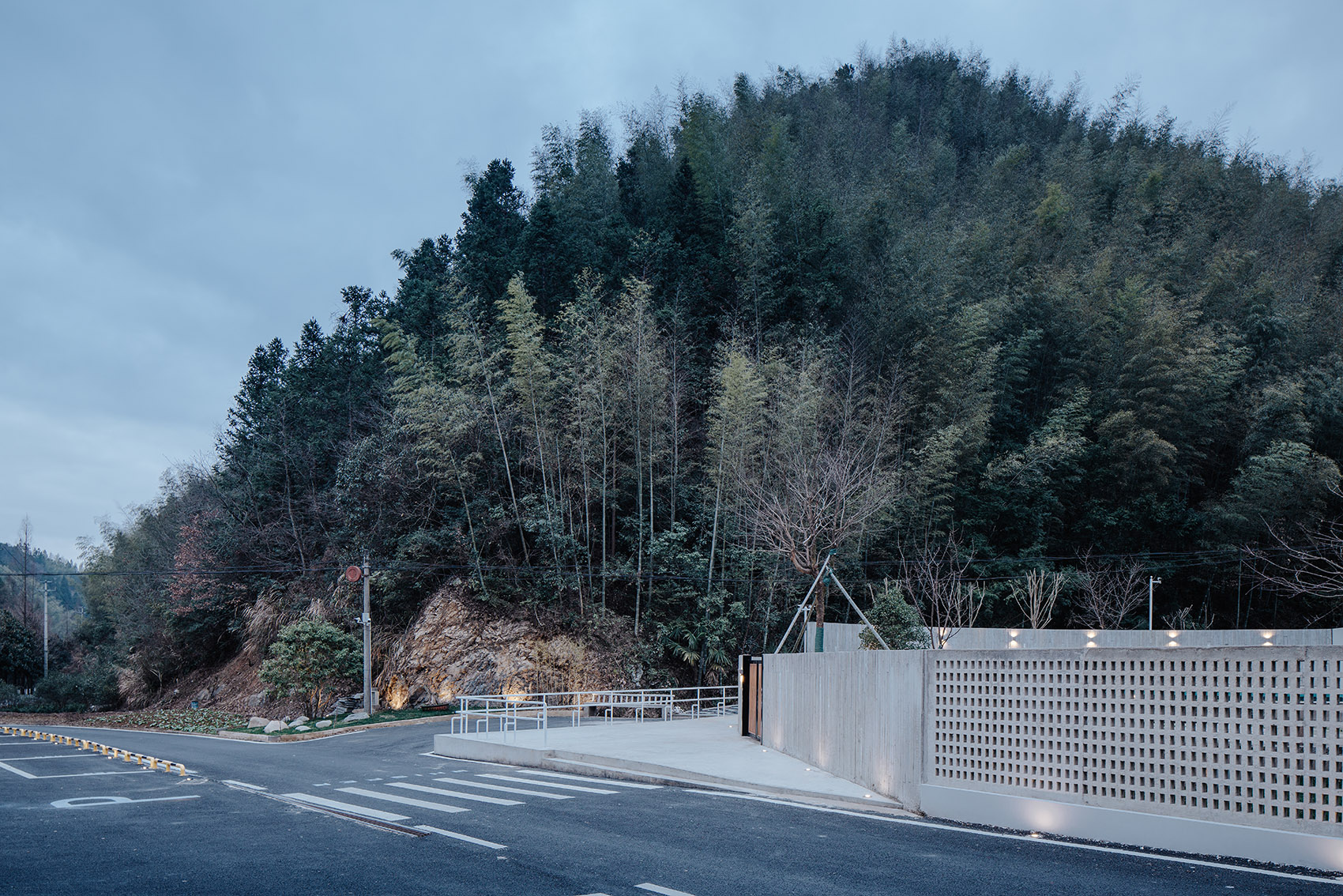
建筑立面和室内使用空间的二次塑造,建筑一层作为整个民宿最重要的公共区域,承载入住接待、用餐、交流以及后勤的部分,二层三层为主要客房区域,顶楼除了多功能厅还有复式二层卧室和户外独立露台,13个客房涵盖不同房型。
Reshaping of the building facade and interior space. The first floor of the building is the most important public area of the whole guesthouse, functioning as the reception, dining room, activity areas, and logistics and support office; the second and third floors are mainly guest rooms; on the top floor, there are duplex two-story bedrooms and an outdoor independent terrace, besides a multi-function hall. There are 13 rooms in total of different size and different designs.
▼一层公共区域,public area ©稳摄影
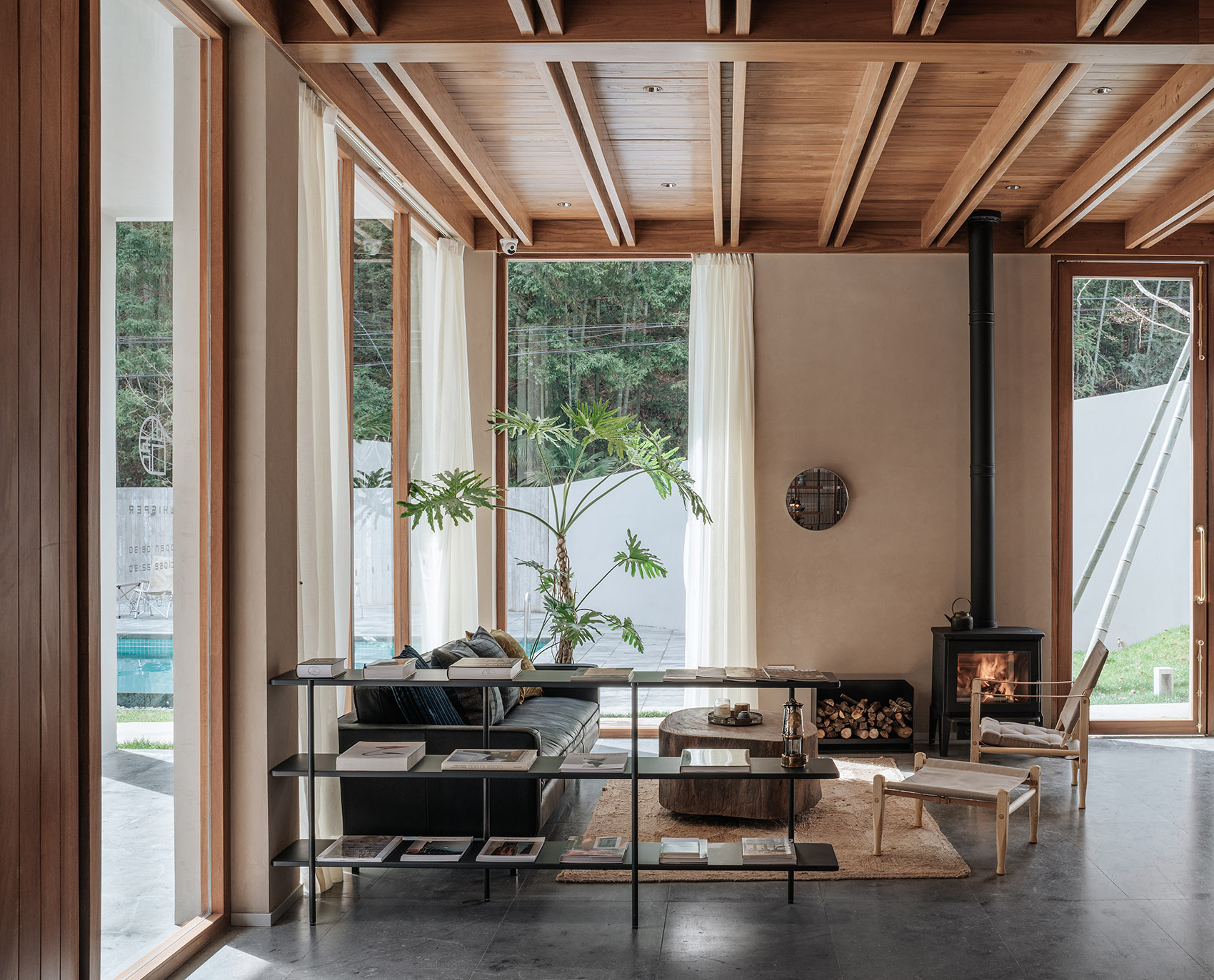
▼餐室,dining area ©稳摄影
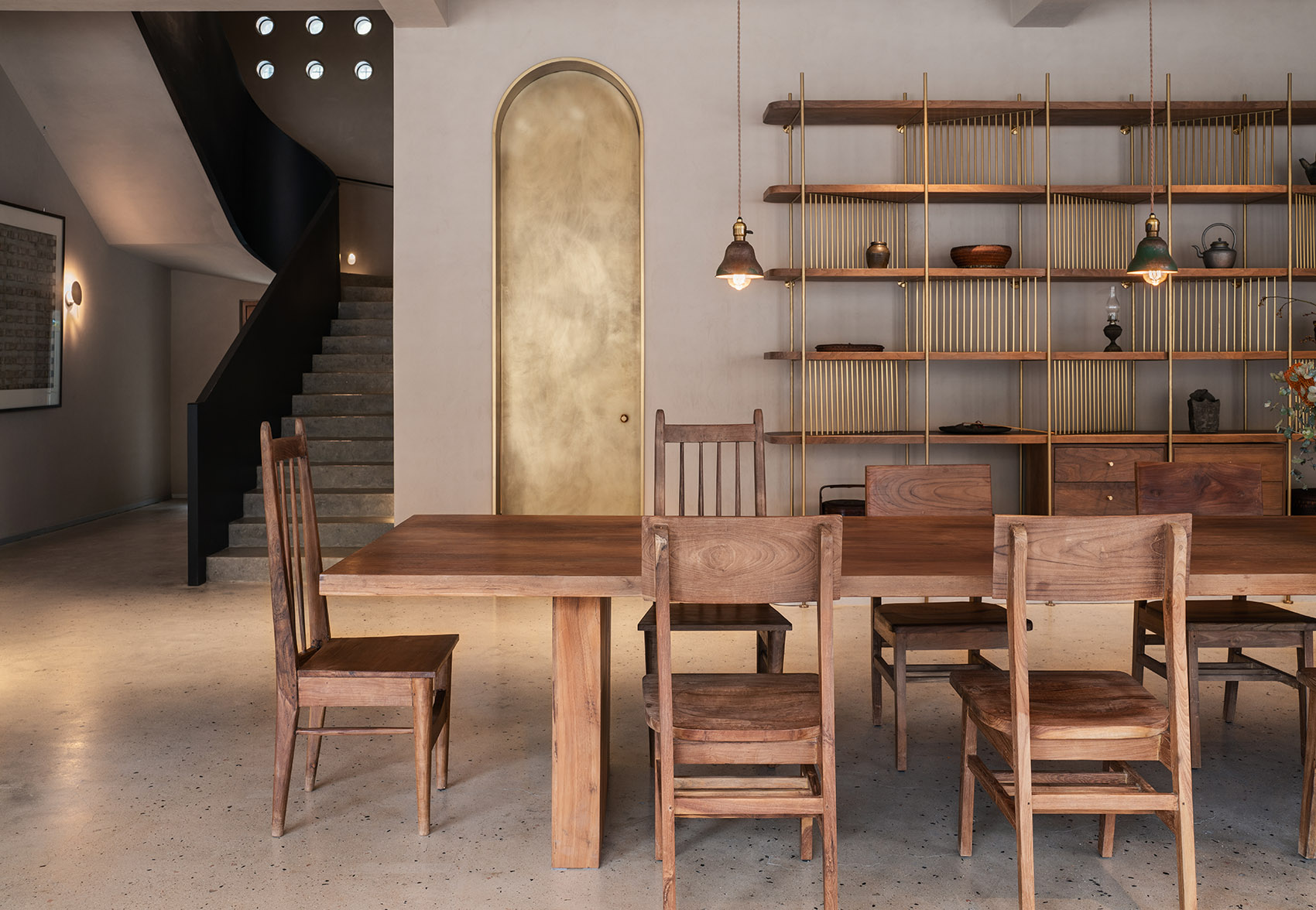
▼吧台,bar area ©稳摄影
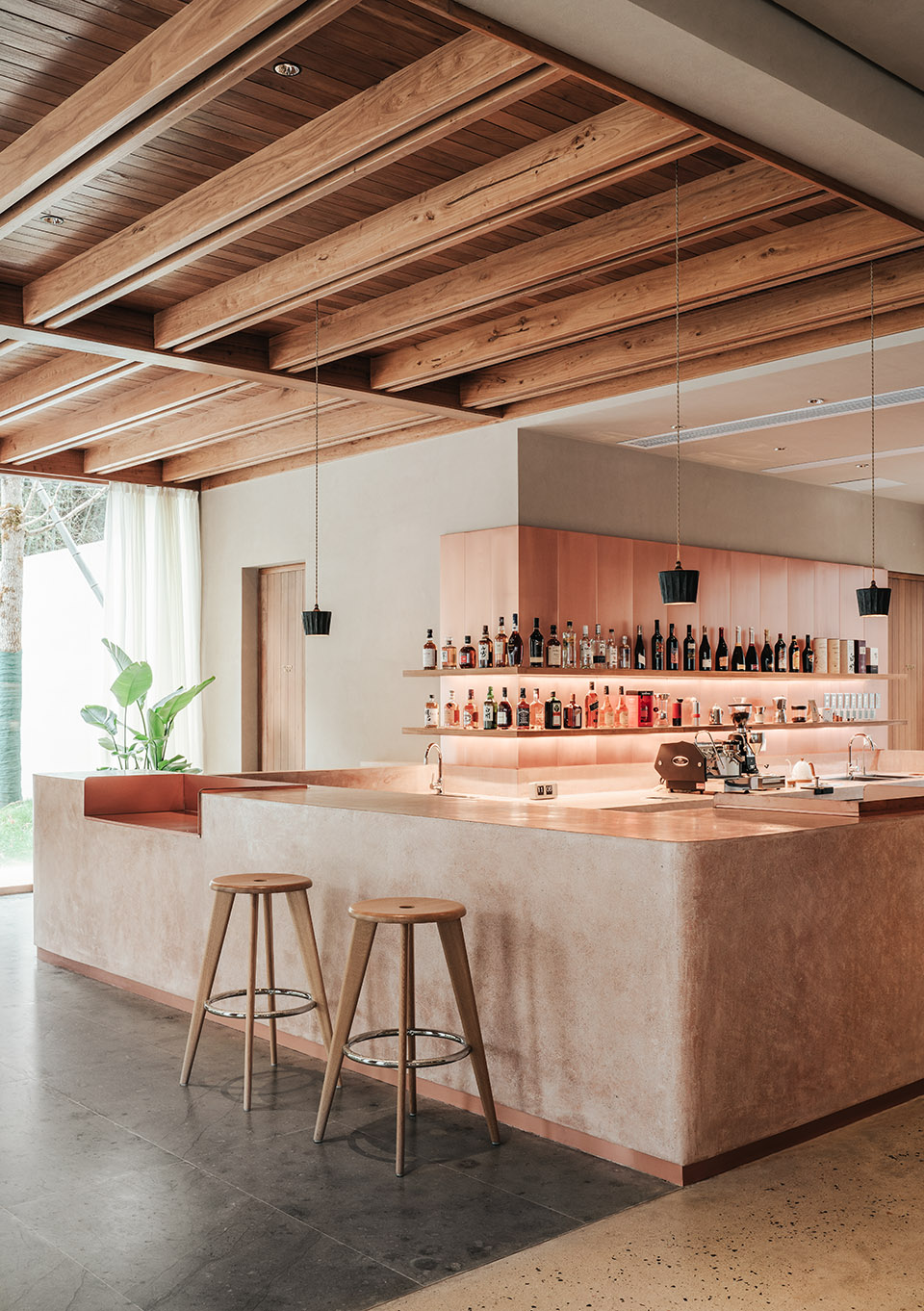
建筑立面原来的门廊被改造成抬高的用餐区域,门廊完全消失将它变成建筑体块中的一部分,增加三楼的飘窗,让建筑立面的摆脱原本的扁平化。拓展房间户外部分,让室内有更多的采光和视觉延伸。主入户门被放置在靠近庭院院门的垂直视线上。由于相对高差较大,在庭院门与室内空间设计了一条无障碍的坡道,庭院被拆分成三个高度,泳池和室内地坪处在最高的平台上,庭院入户是第一个独立的高度平台,第二个高度是庭院的石板硬化面。
On the building façade, the original porch is converted into a raised dining area as a part of the façade; on the third floor, bay windows are added to form a three-dimensional effect, which also expands the outdoor part of the room, allowing more sunlight for the rooms and creating a visual extension. The main entrance door is designed on a vertical line-of-sight near the courtyard door. Because of large gap of relative height difference, an accessible ramps is placed between the courtyard door and indoor space. So the courtyard door is divided into three, of different heights; the pool and the indoor floor are on the highest terrace; The courtyard entrance is the first independent height terrace; the courtyard entrance is the first independent height terrace,and the second on is the SLATE surface of the courtyard.
▼建筑立面,building façade ©稳摄影
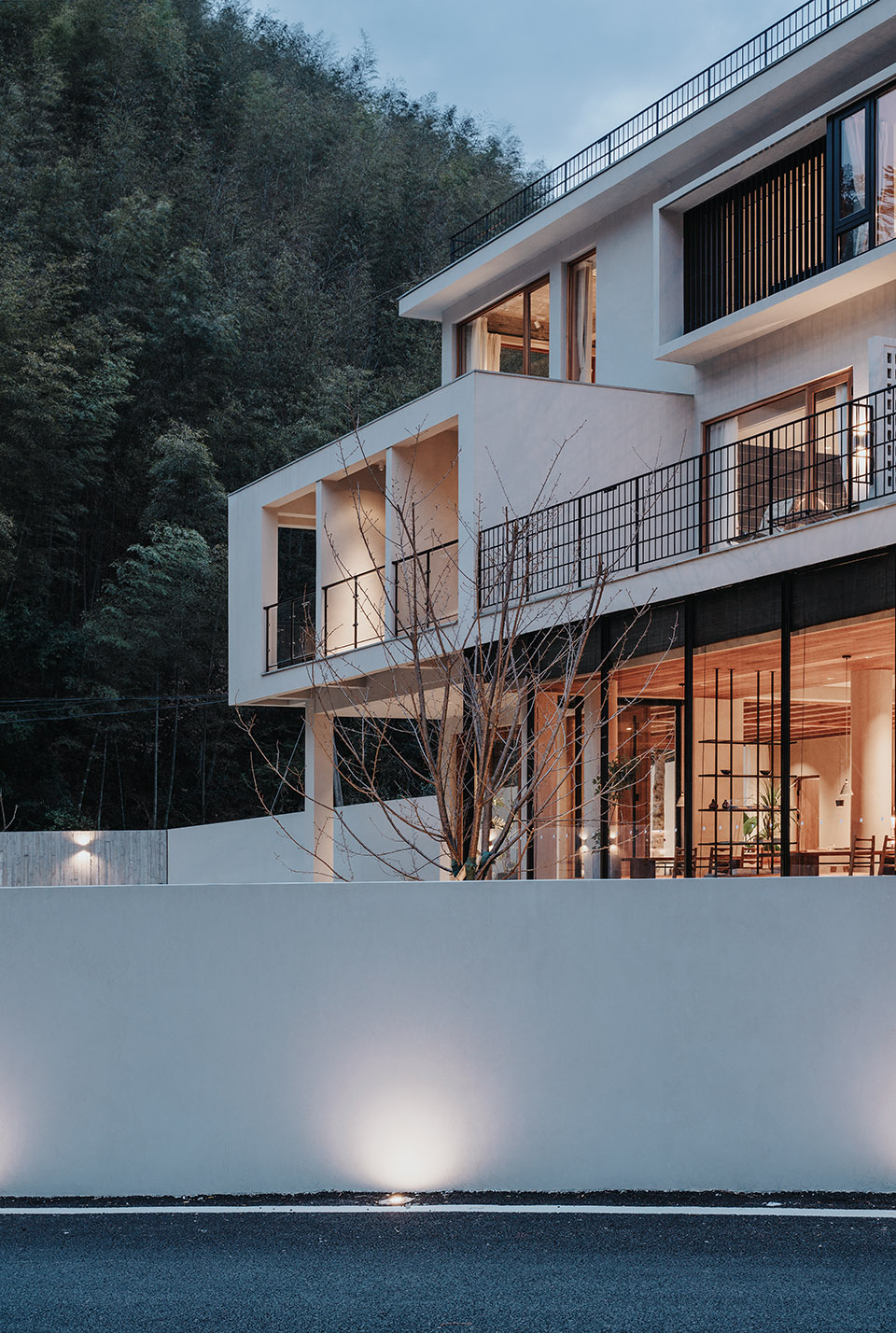
▼增加三楼的飘窗,让建筑立面的摆脱原本的扁平化,on the third floor, bay windows are added to form a three-dimensional effect ©稳摄影
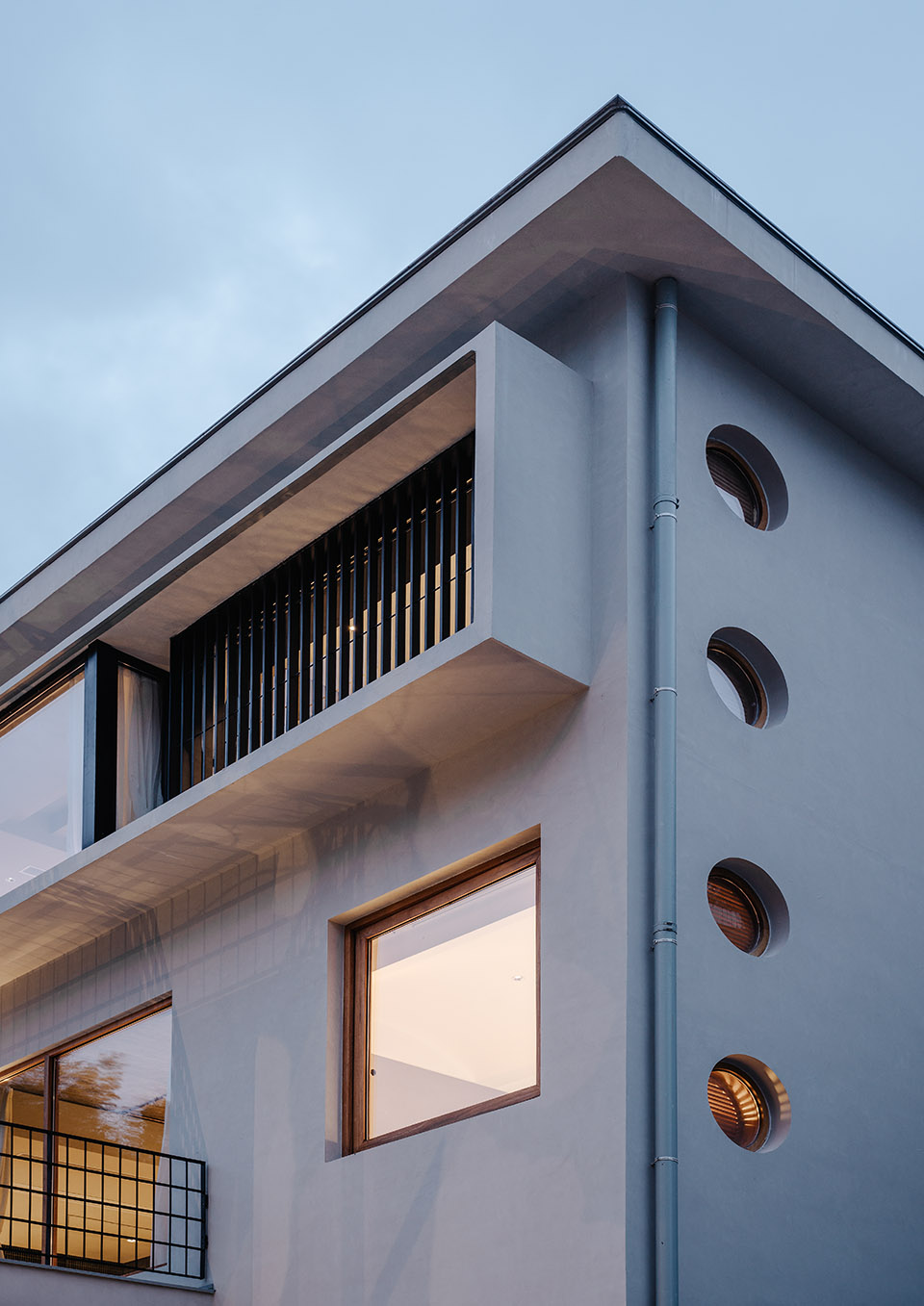
在动线设计中,除了功能型流线以外还有建筑中隐形的游走路线,你可以选择快速到达的路线,也可以尝试选择弧形楼梯和外挑楼梯的结合线路。游走在建筑中看到的局部,以视觉的方式在记忆中形成一个相对完整的碎片整体。
In the motion trend designing, there are invisible wandering routes in the building besides the functional streamlines. As a result, you may choose to follow a quick route to get your destination, or to try arc stairs, or projecting stairs, or both. As you’re walking around in the building, your mind will form an overall impression, which is stored in a fragmented visual way.
▼从走廊望向公共区,view to the public area from the corridor ©稳摄影
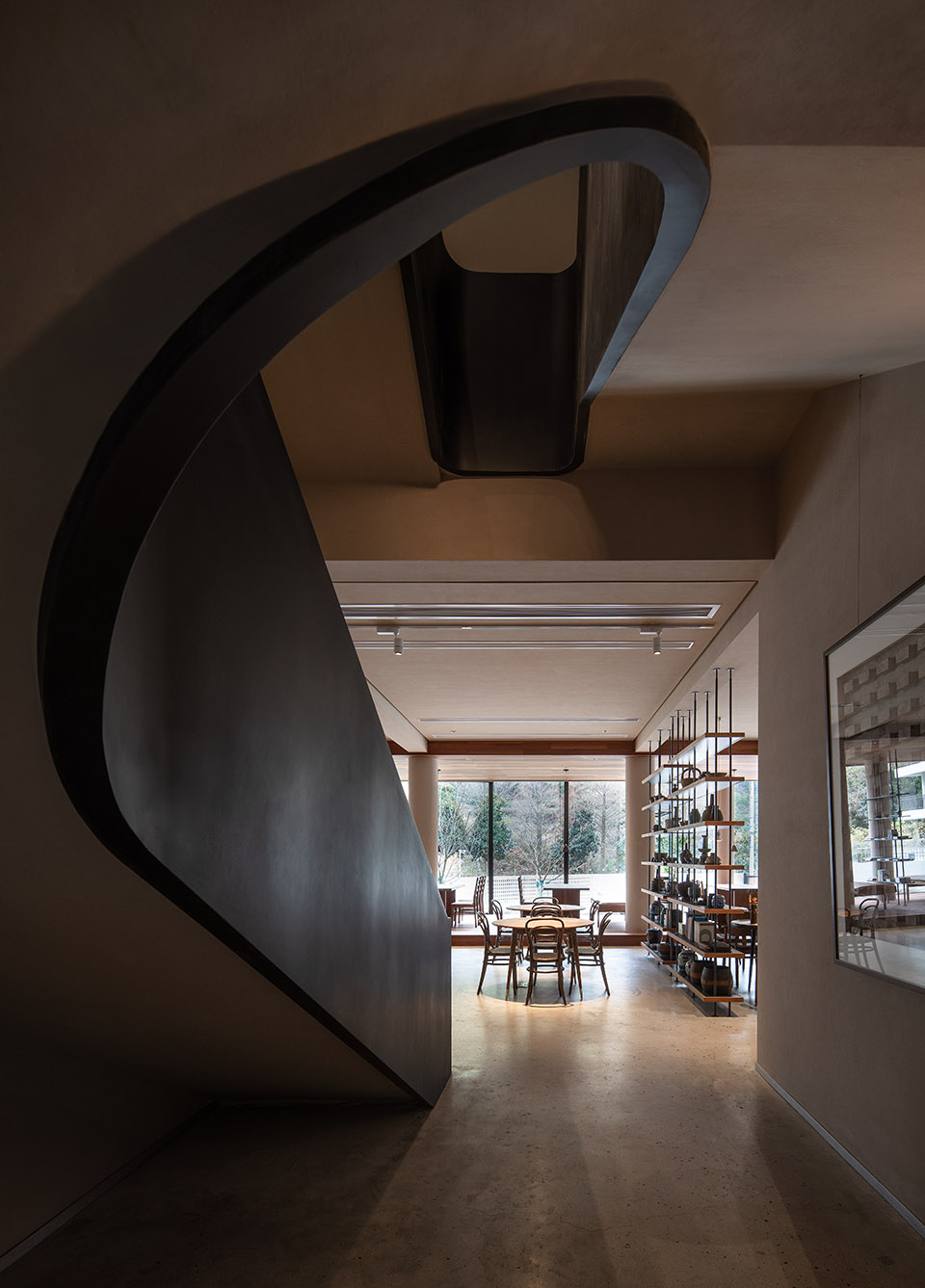
▼楼梯,the stairs ©稳摄影
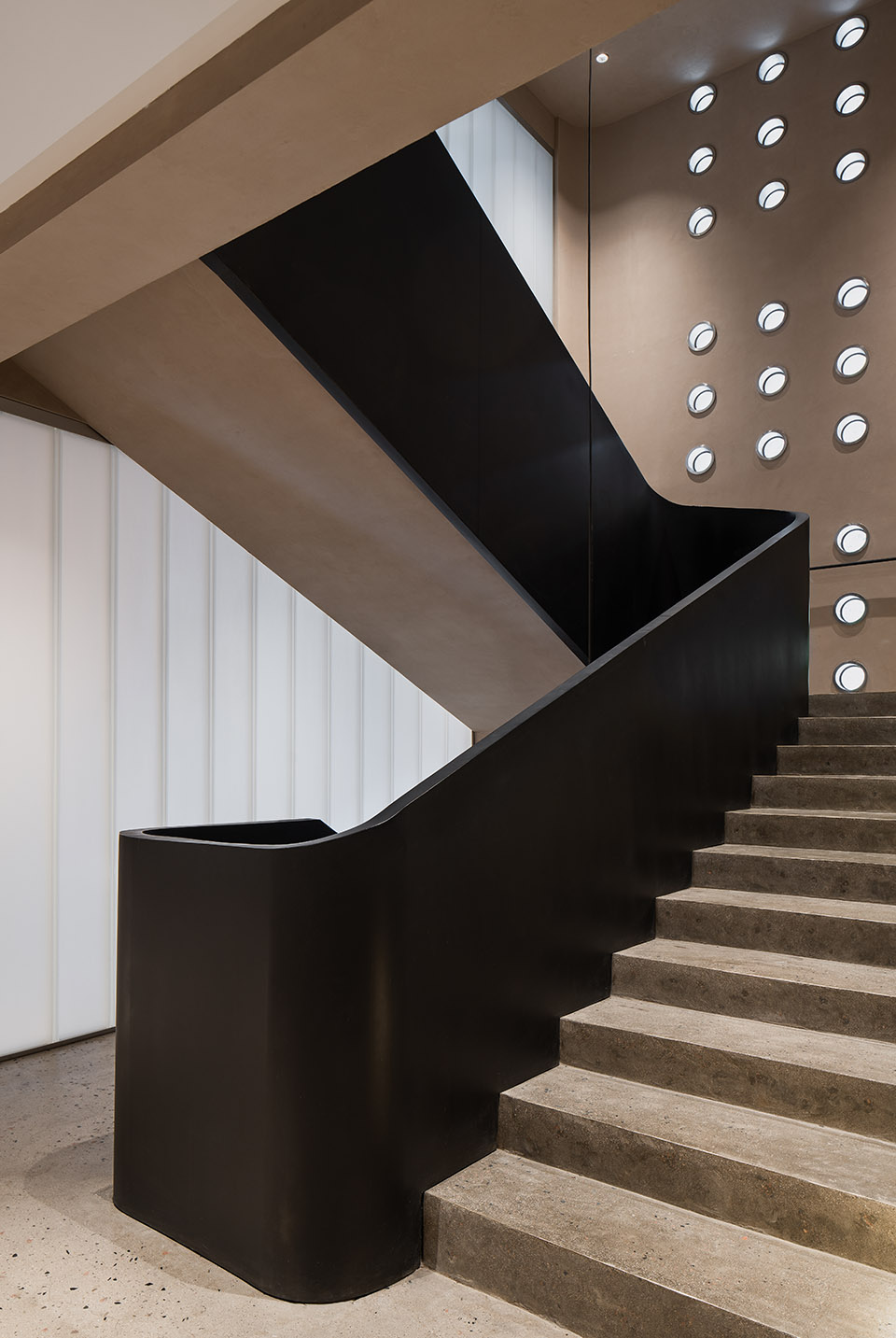
在整个项目空间的改造中,试图使用天井的植入达到不同程度上的空间交叠关系。我们在主建筑和辅助建筑中间设置了采光天井让一楼的北向有大的进光量和空气对流。主楼梯天井的改造,原本的楼梯台阶在俯视的角度只预留了扶手的间距,通过一楼的楼梯是重新浇筑和二楼和三楼楼梯的天井改造,实现贯通三层建筑高度的楼梯天井,某种层度上也是达到间隙空间的引导作用,另外还有一个辅助的小天井,在二楼和三楼之间,增加空间趣味性的同时也可以为室内争取更多北向的采光面,复式的二层的长条天窗虽然以前的改造项目中也有出现,这次采用全无框的处理,总感觉顶面进光方式总让人有一种神秘感。边界被适当地表现出来,那么内部就可以看作是它的领域。抵消也可以是开创的一部分。
▼楼梯天井,stair well ©稳摄影
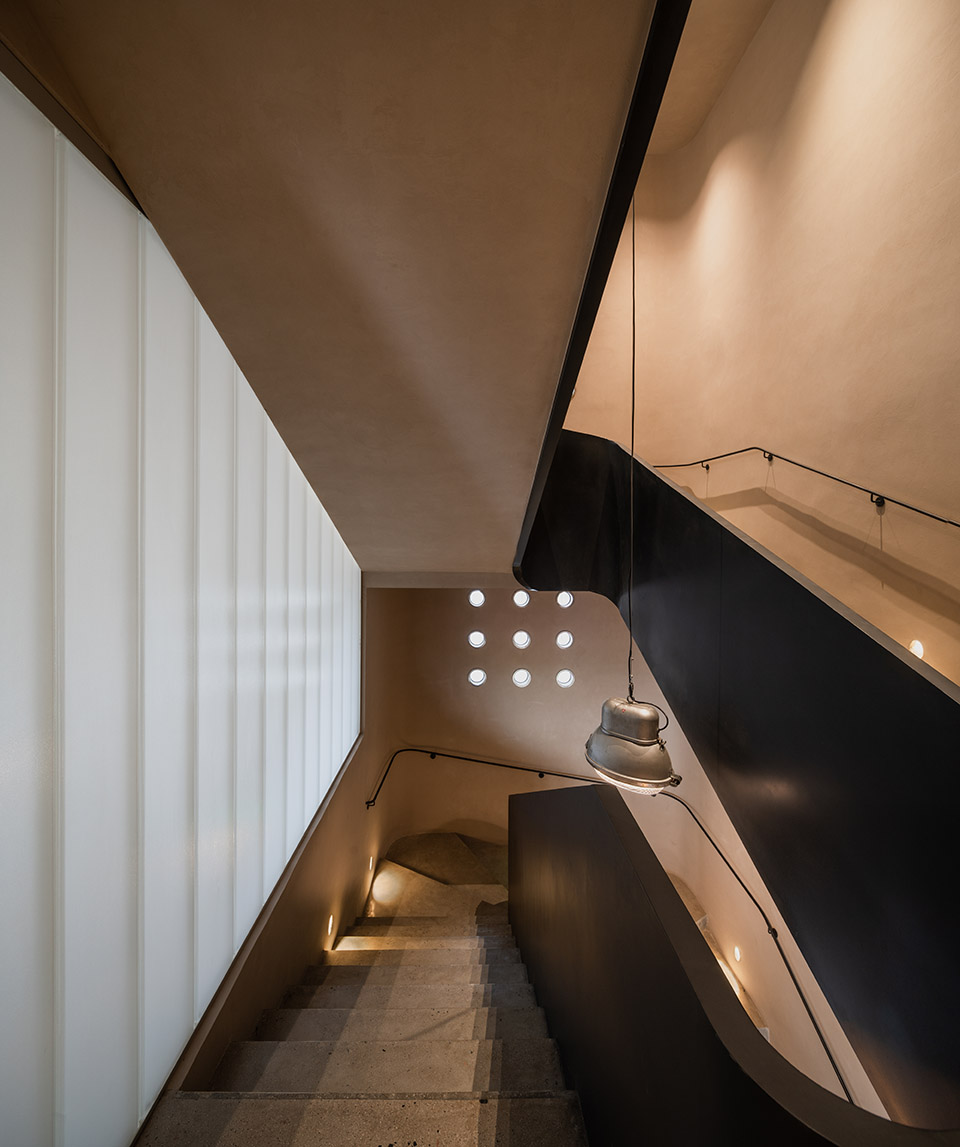
In the transformation of the whole project, the insertion of the patio makes it possible to overlap the spaces to different degrees. A light patio between the main building and its auxiliaries is designed to allow a large amount of light and air convection from the north direction of the first floor. As for the patio of the main staircase, the original stair steps are only reserved for handrails at a bird ‘s-eye angle. The staircase through the first floor is re-poured and the patios both of the second and third floors are all renovated, to form a whole patio going through three floors. To a certain extent, this is also the guiding effect of the clearance space. There is also an auxiliary small patio between the second and third floors, increasing the interest of architectural space while maximizing the daylighting for the north space. Although long skylight of the second floor has been retrofitted before, this time, we use frameless processing completely and allow sunlight to enter into space from the roof, creating a sense of mystery. The appropriately represented boundary indicates it has an interior domain. Offsets can also be part of the creation.
▼顶面进光方式带来神秘感,sunlight enters into space from the roof, creating a sense of mystery ©稳摄影
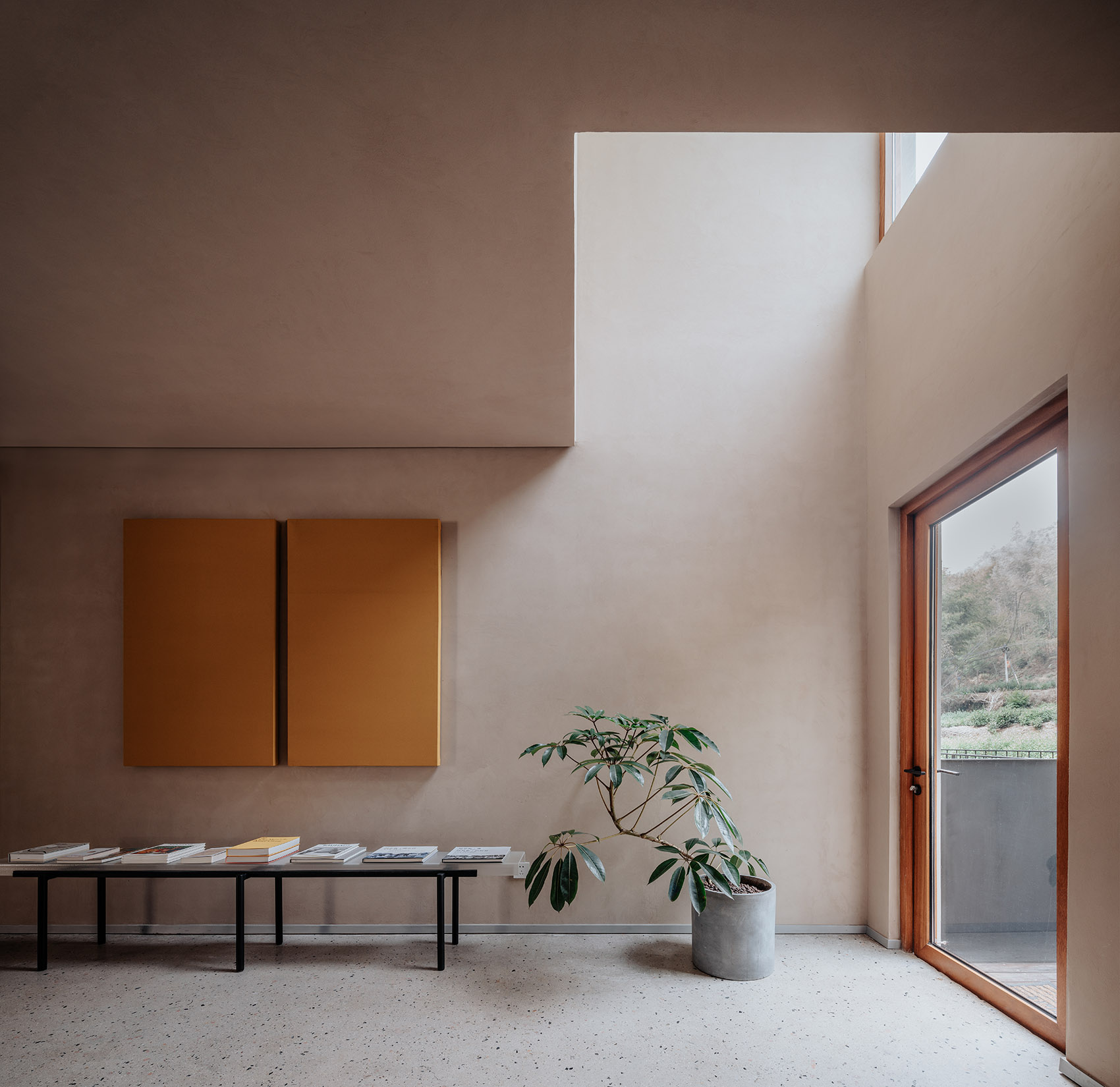
对事物的最初认识和相处方式都会被放大在自己的记忆中。在建筑构件和室内设计的部分都可以看到类似的处理方式,露台格栅的铁艺栏杆和现浇混凝土扶手;长条飘窗上窗户立面竖向格栅;楼梯天井阵列圆形采光窗;方形格栅的茶室隔断和木门; 顶楼窗户立面横向方格分割。弧形的元素最开始的使用是在围墙处理上,我们希望放大弧形元素的使用范围,顶楼的多功能厅的弧形轮廓处理,可以把它想象成放置在屋顶的巨大玻璃储水箱;主楼梯天井边缘的弧形处理,以及复式房间的弧形楼梯,包括后期的视觉系统也带有弧形的元素。这个部分其实在室内材质的使用上也可以看到,它们不是单一出现一个空间当中,而是用整体归纳的方式被使用,新旧茶园石的地面;磨砂U形玻璃隔断和茶几;不同灰度肌理涂料;金属面…,虽然使用材质不多,多形式和重复出现的方式,包括对应的材质在家具上的使用,都如同在记忆中放大了的样子。有相似性的同时存在差异,让各个部分的变化保持着一种关联性。
▼顶层休闲区的弧形立面,the curved facade of the top-floor lounge ©稳摄影
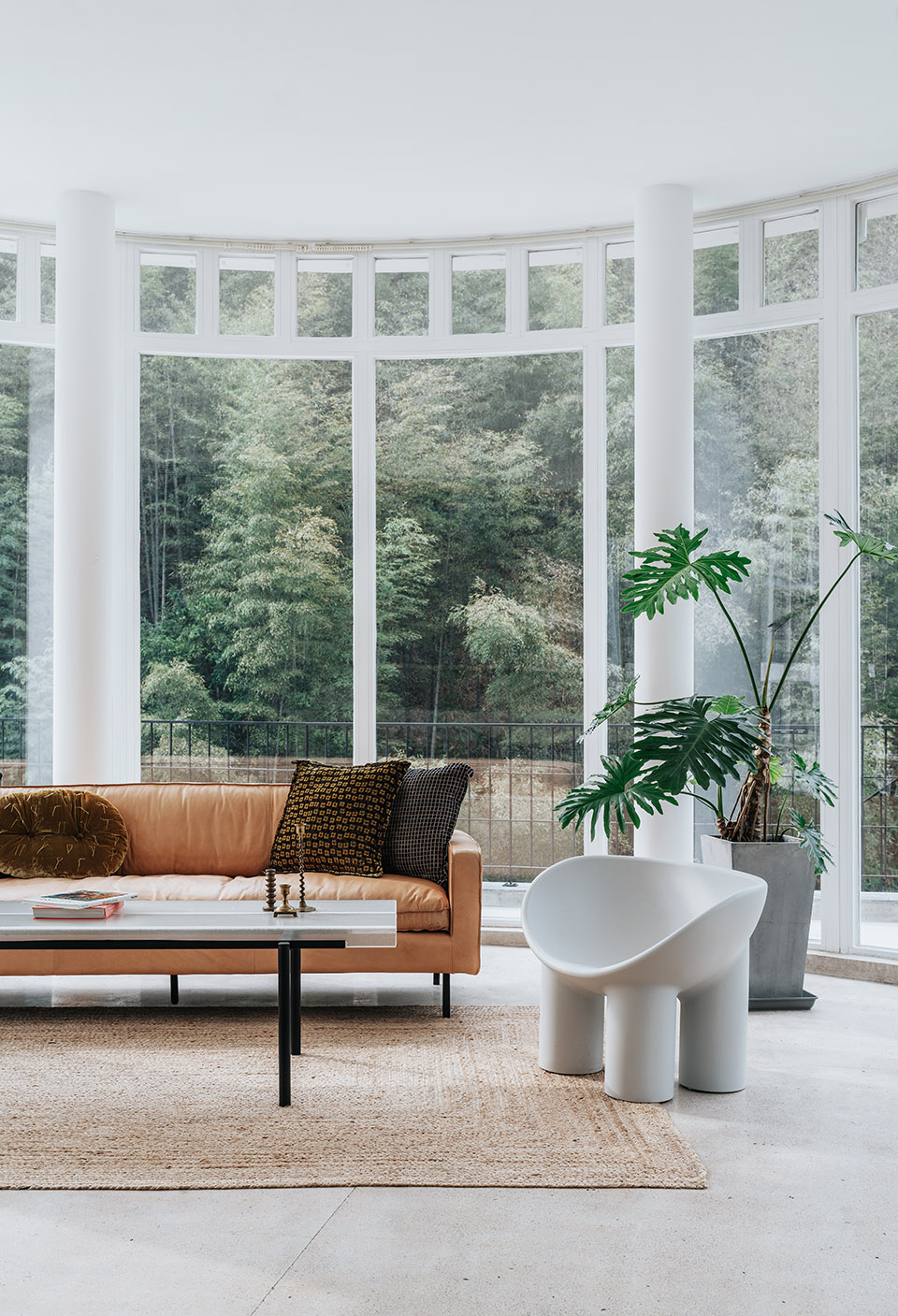
▼茶室采用方形格栅隔断,the partition with square grille in the tea house ©稳摄影
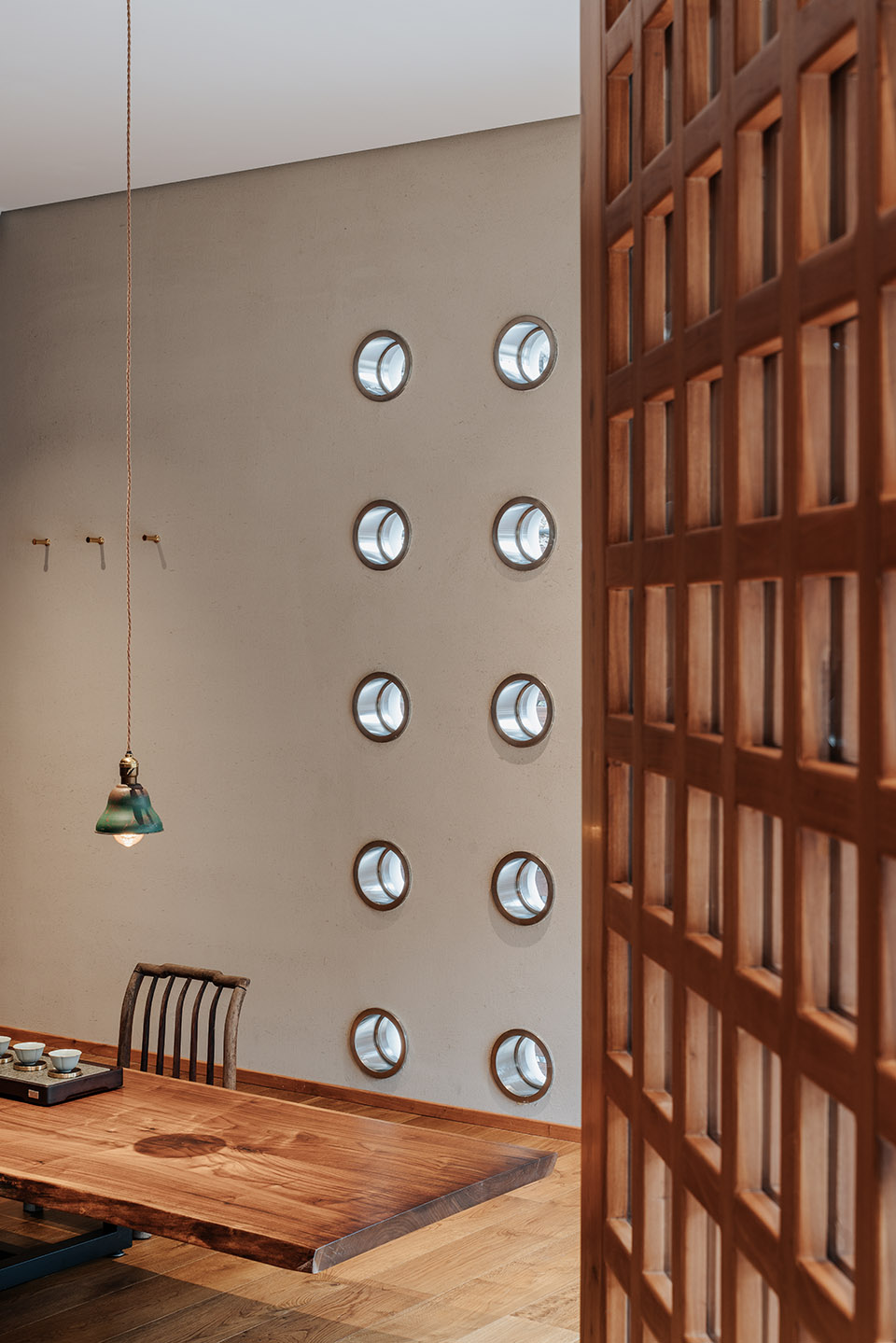
The initial understanding of and the way to get along with things will be magnified in our memories. It is common to find similar treatment in both architectural components and interior design, such as terrace grille with wrought iron railings and cast-in-place concrete handrails, vertical grille of a window facade on a long floating window, circular windows in stair patio arrays, teahouse partition with square grille and wooden doors, and horizontal grid division on the facade of the penthouse window. The arc element, originally used in the enclosure treatment, is used for the contour treatment of the multi-function hall on the top floor, for we want to enlarge the range of arc elements. Image it as a huge glass storage tank on the roof. arc elements are also adopted in the main stair patio edge treatment, the arc stair of double entry room and the post visual system. This can also be found in the use of indoor materials. Rather than singly appearing in a space, they are used in a generalized way, for example, ground made of old and new Chayuan stones, U-shaped ground glass partition and tea table, paintings with different grayscale texture, metal surface……although not too many materials are used, but they are presented in different forms many times, including use of the corresponding material on furniture, as if they are magnified in our memories. Similarities and differences co-exist at the same time, so that the changes of each part maintain a kind of relevance.
▼休闲区室内细节,lounge area detailed view ©稳摄影
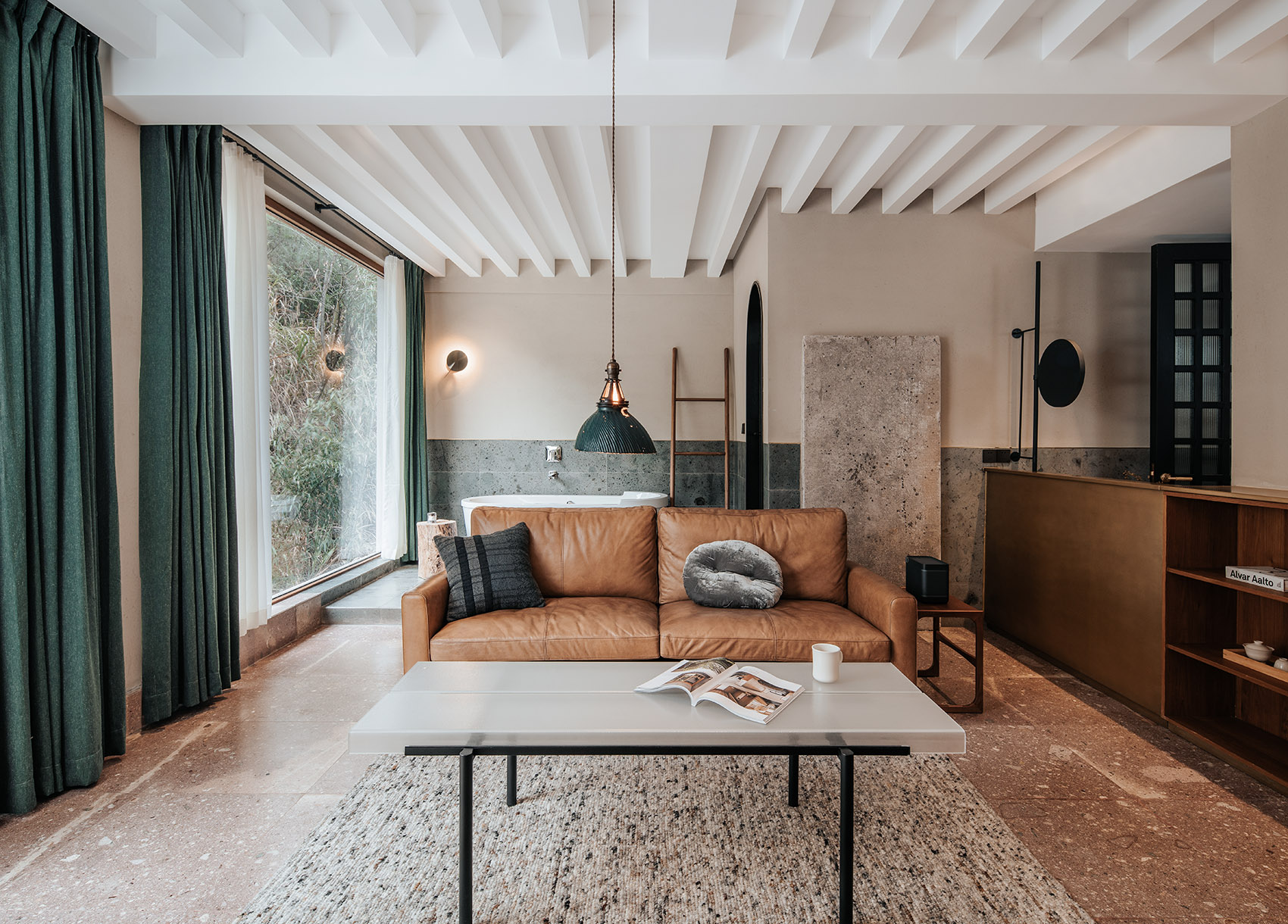
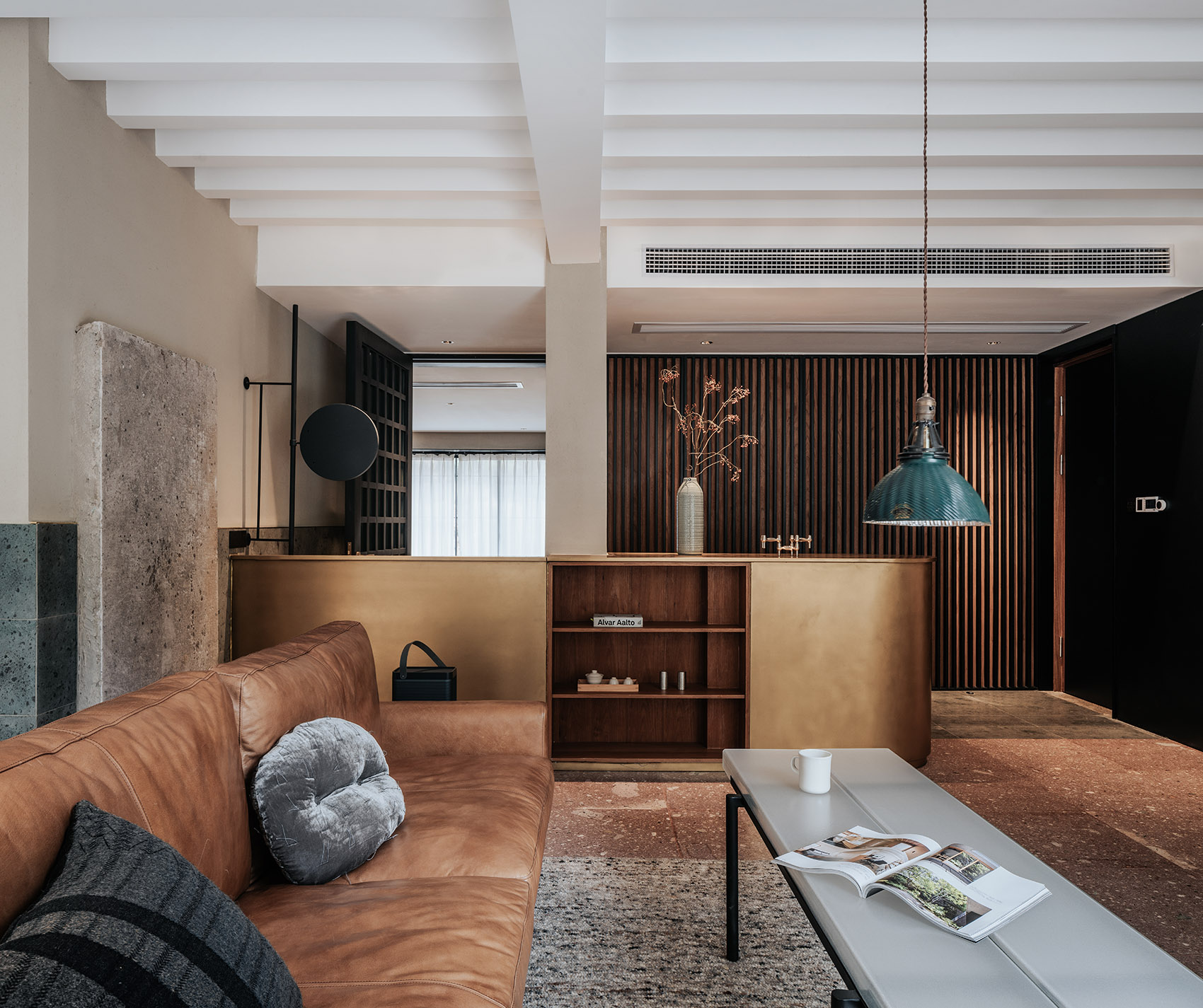
▼客房,guest room ©稳摄影

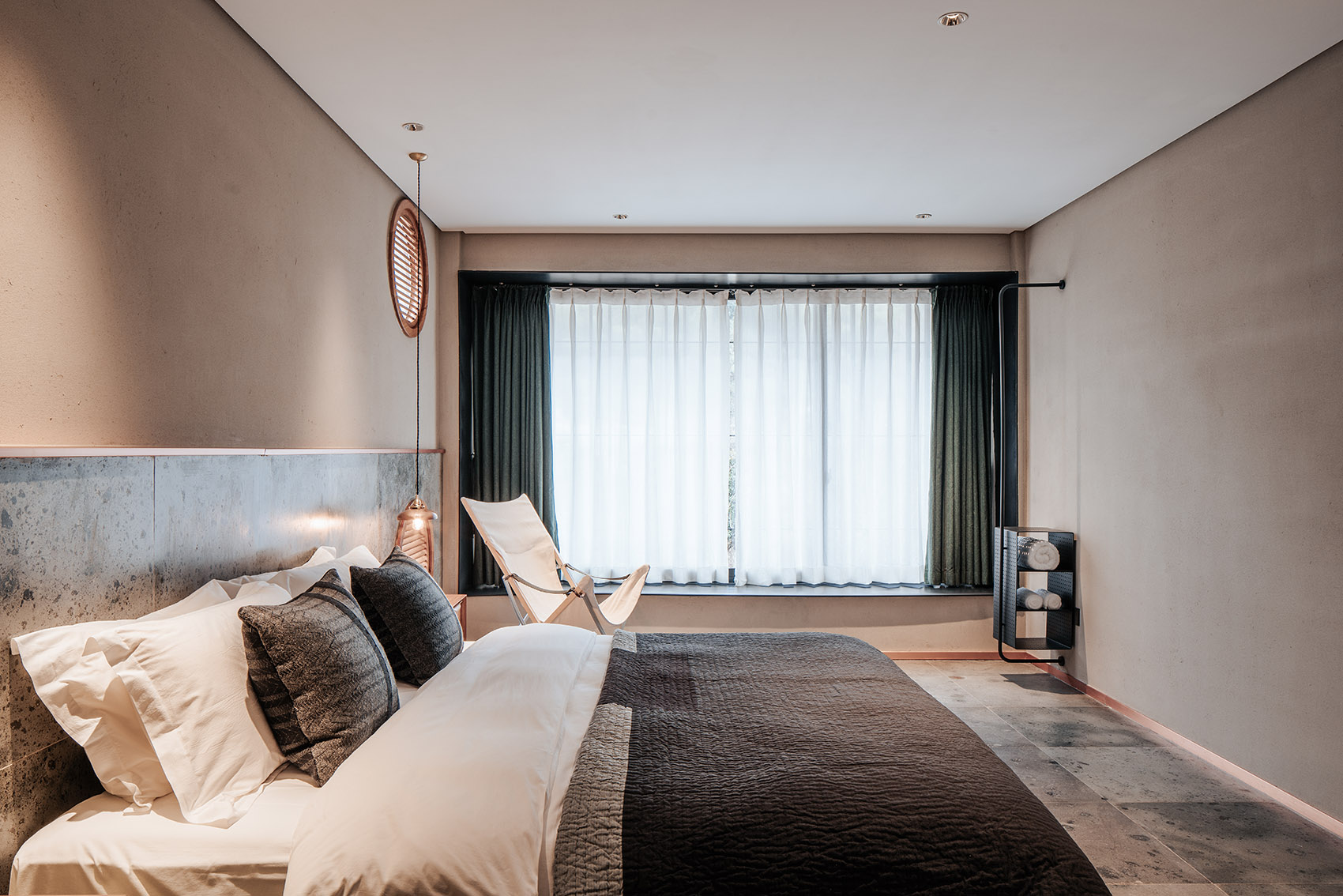
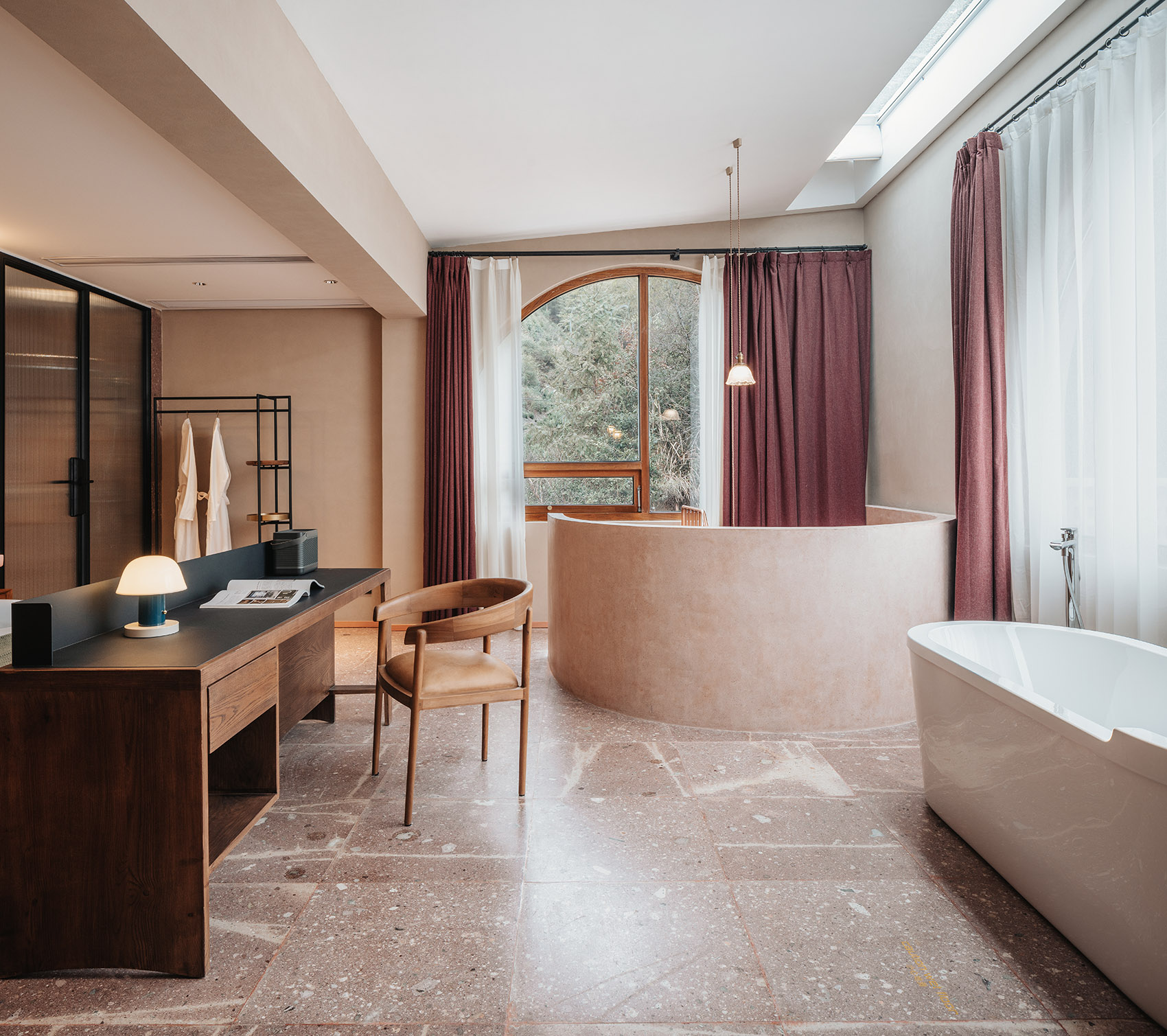
▼客房浴室,bathroom ©稳摄影
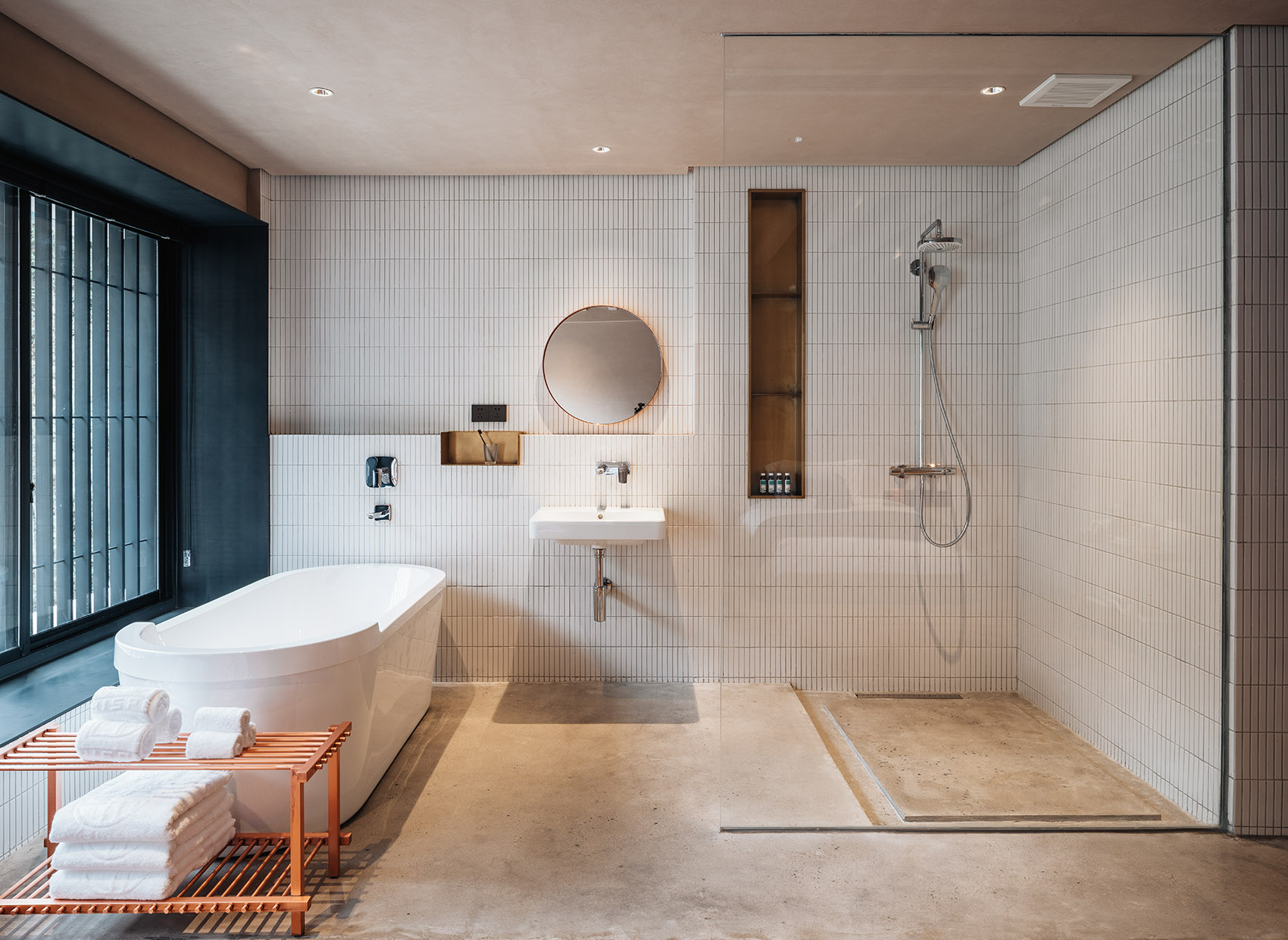
塑造人与人有交流氛围的空间 ,我们所理解的地域性文化的强调并不是整齐划一的元素拼贴术,应该是促进交流和接触在地的文化,包括生活器物的收藏或者是当地食材和美食做法追溯等,建筑与室内空间是被使用或者说是服务性空间,更符合当下居住要求的乡村产业改造也是必然的,项目改造本身就是打破关系和塑造关系的一种试探。
▼轴测图,axon ©静谧设计研究室
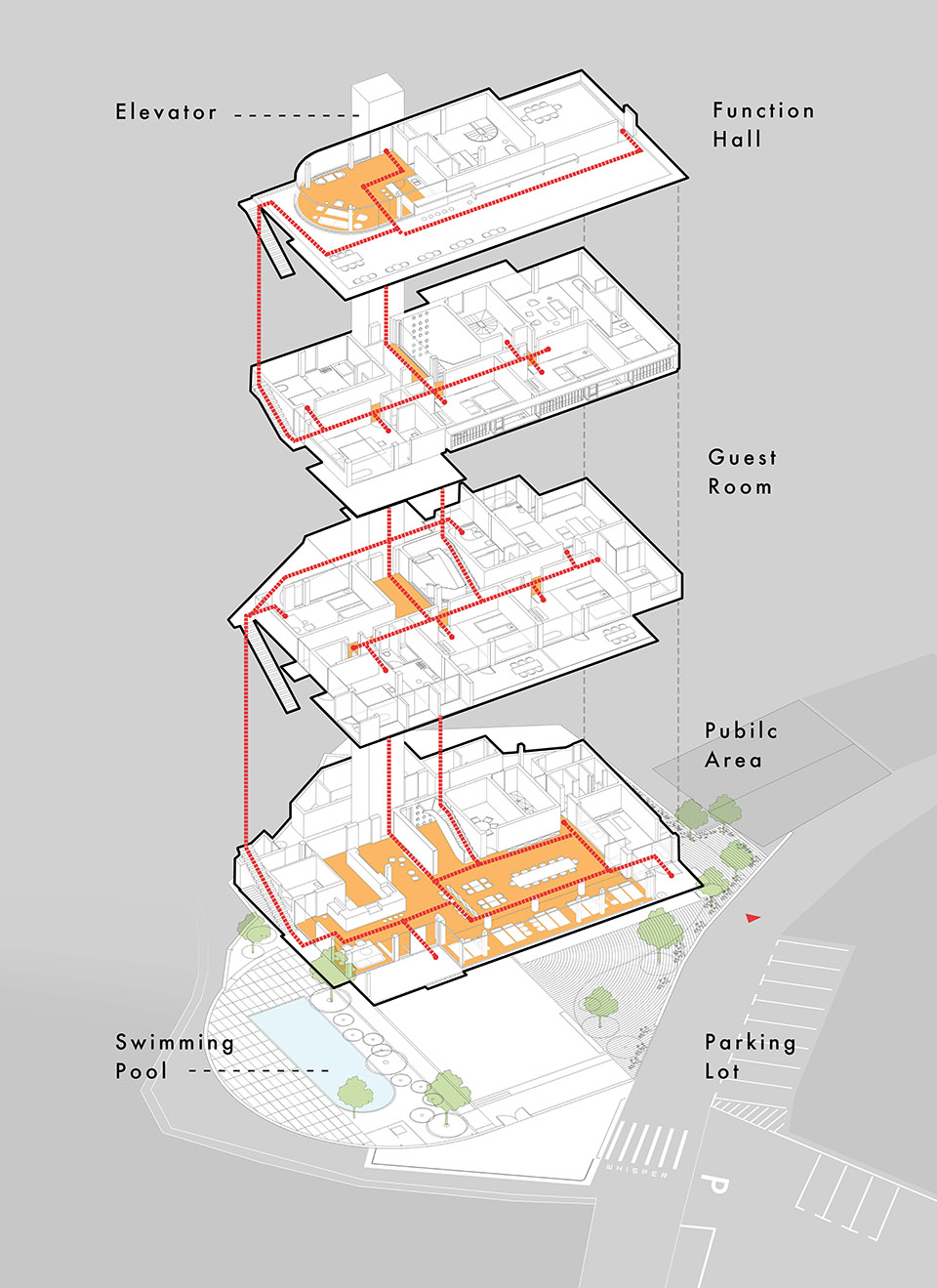
▼立面图,elevations

▼剖面图,sections ©静谧设计研究室
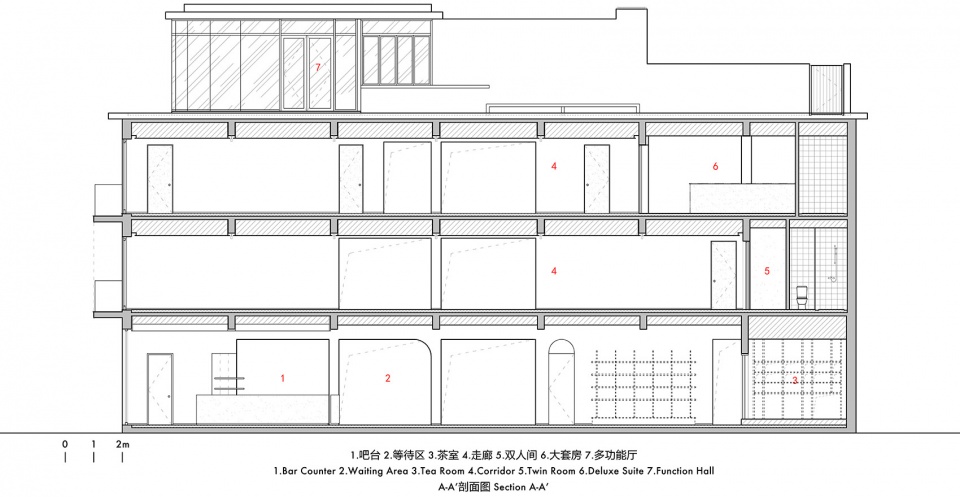
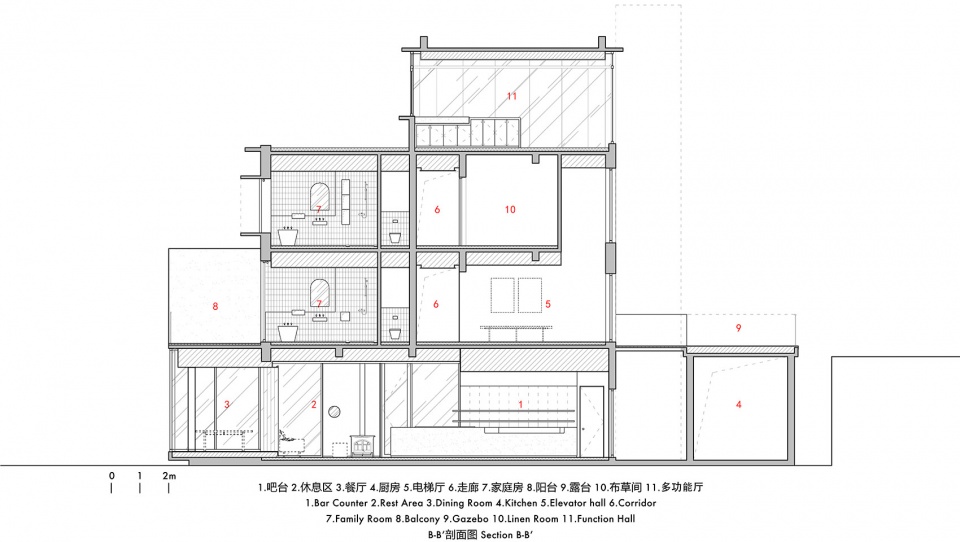
▼通道及挑空示意图,circulation core diagram ©静谧设计研究室

项目名称:黄山山语民宿 设计单位:静谧设计研究室 qpdro 主创设计:林世明 ,李霞 结构设计:陈强 项目规模:室内面积1290平米 设计时间:2018年3月 施工时间:2018年6月-2019年11月 项目地点:黄山汤口 项目类型:精品民宿 平面设计:周洪设计研究室 标识制作:良良广告 项目拍摄:稳摄影 家具品牌:Enjoy space,solife,LostandFound 主要材料:茶园石\水磨石\肌理涂料\铁艺金属 \菠萝格
